 Capella-Alpha Aurigae of the Auriga constellation, is the 6th brightest in the night sky and is a non-eclipsing binary star system of four stars in two pairs that cannot be broken down even as two-stars looking through a regular telescope but this image appears as four free morphemes here due to excellent parsing. A Rs Canes Venaticorum type with high chromospheric starspots that cause variations in luminosity, the pair is orbited by a pair of distant flare red dwarfs.
Capella-Alpha Aurigae of the Auriga constellation, is the 6th brightest in the night sky and is a non-eclipsing binary star system of four stars in two pairs that cannot be broken down even as two-stars looking through a regular telescope but this image appears as four free morphemes here due to excellent parsing. A Rs Canes Venaticorum type with high chromospheric starspots that cause variations in luminosity, the pair is orbited by a pair of distant flare red dwarfs.
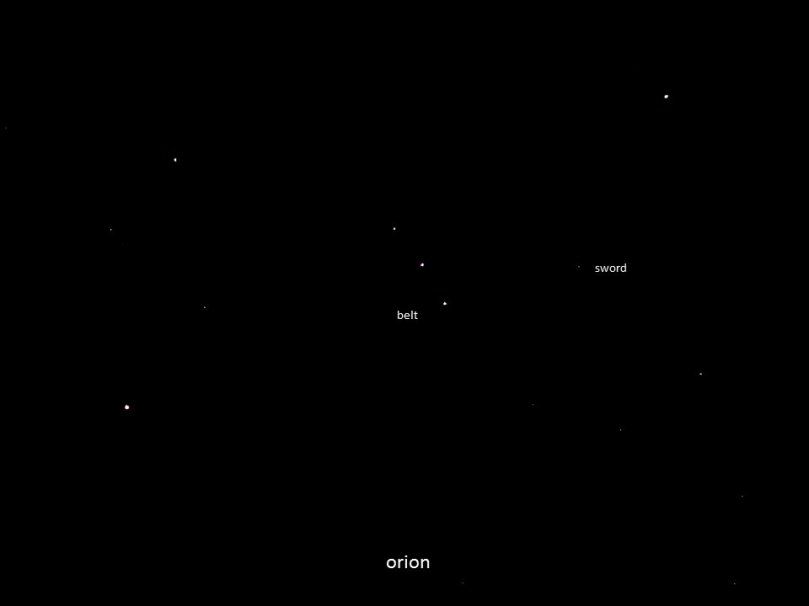 Orion constellation clearly visible in the night sky from November-February. Orion is in the southwestern sky if you stay in the North or the northwestern sky if you stay in the South. Latitudes between +85° & -75° are recommended.
Orion constellation clearly visible in the night sky from November-February. Orion is in the southwestern sky if you stay in the North or the northwestern sky if you stay in the South. Latitudes between +85° & -75° are recommended.
 Seafood transgravitate toward the northwards Mars pole & into warmer areas inside of Hollow Mars through an opening. Some were cryopreserved and turned to ice before reaching the “inner paradise”. No redemption possibly. [Call of the sea primitives.]
Seafood transgravitate toward the northwards Mars pole & into warmer areas inside of Hollow Mars through an opening. Some were cryopreserved and turned to ice before reaching the “inner paradise”. No redemption possibly. [Call of the sea primitives.]

 A comet is an icy small Solar System body that, when passing close to the Sun, warms and begins to release gases, a process called outgassing. A coma and sometimes an ion tail are produced as seen from this 252P Comet/LINEAR as solar winds charge particles blow the gas trails away from the Sun and materials to become meteor trailers. 252P Comet is a periodic comet and near-Earth object, it is also an Earth-Jupiter family comet, passing quite close to both the planets. Comet nuclei range from a few hundred meters to tens of kilometres across and are composed of loose collections of ice, dust, and small rocky particles. The coma may be up to 15 times the Earth’s diameter, while the tail may stretch one astronomical unit. A comet may subtend an arc of 30° (60 Moons) across the sky.
A comet is an icy small Solar System body that, when passing close to the Sun, warms and begins to release gases, a process called outgassing. A coma and sometimes an ion tail are produced as seen from this 252P Comet/LINEAR as solar winds charge particles blow the gas trails away from the Sun and materials to become meteor trailers. 252P Comet is a periodic comet and near-Earth object, it is also an Earth-Jupiter family comet, passing quite close to both the planets. Comet nuclei range from a few hundred meters to tens of kilometres across and are composed of loose collections of ice, dust, and small rocky particles. The coma may be up to 15 times the Earth’s diameter, while the tail may stretch one astronomical unit. A comet may subtend an arc of 30° (60 Moons) across the sky.
 Sheliak, a βeta Lyrae variable blue white star in Lyra constellation, has a smooth eclipse difficult to tell due to velocity & extrinsic periodicity of luminosity with variation from apparent magnitude of +3.2 to +4.4 over an orbital period of 12.94 days. Beta Lyrae is a semidetached binary system made up of a primary B7 main sequence star and a secondary B-type star. The fainter star in the system was once the more massive member which evolved away from the main sequence first and became a giant star.
Sheliak, a βeta Lyrae variable blue white star in Lyra constellation, has a smooth eclipse difficult to tell due to velocity & extrinsic periodicity of luminosity with variation from apparent magnitude of +3.2 to +4.4 over an orbital period of 12.94 days. Beta Lyrae is a semidetached binary system made up of a primary B7 main sequence star and a secondary B-type star. The fainter star in the system was once the more massive member which evolved away from the main sequence first and became a giant star.
As it filled its Roche lobe, it transferred most of its mass over to its companion, which is now more massive and surrounded by an accretion disk from this transfer. The amount of mass transferred between the two stars is about the Sun’s mass every 50,000 years. It is ellipsoidally deformed with the big star roche lobe’s accretion disk eject matter blocking the main view, lowering the brightness. When the small star blocks the big one, a secondary minimum apparent magnitude is generated at +3.8.
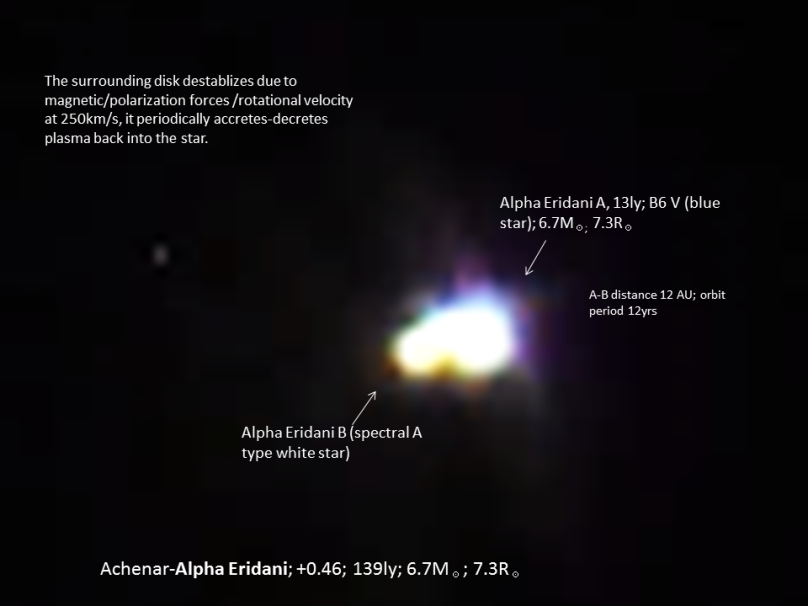 Achernar, Alpha Eridani, is the brightest point of light lying at the southern tip of, Eridanus constellation, and the tenth-brightest. The two components are designated Alpha Eridani A and B. It is the least spherical star and assumes an oblate spheroid with an equatorial diameter 56%> poles. It is surrounded by an extended envelope or a circumstellar disk detected by its infrared emission & ionized gas, which is common in Be stars. The star is an eruptive irregular variable type which means that its size and brightness change over time with no regular periodicity. It’s brightness ranges from a magnitude +0.46 to +0.398 over its variable period lasting for 2.5 hrs.
Achernar, Alpha Eridani, is the brightest point of light lying at the southern tip of, Eridanus constellation, and the tenth-brightest. The two components are designated Alpha Eridani A and B. It is the least spherical star and assumes an oblate spheroid with an equatorial diameter 56%> poles. It is surrounded by an extended envelope or a circumstellar disk detected by its infrared emission & ionized gas, which is common in Be stars. The star is an eruptive irregular variable type which means that its size and brightness change over time with no regular periodicity. It’s brightness ranges from a magnitude +0.46 to +0.398 over its variable period lasting for 2.5 hrs.
 Olympus Mons is a shield volcano known as the Albedo Feature Nix Olympica reminiscing the great celestial combo of black tortoise, serpent & azure Dragon. Slopes are highest at the caldera’s center and gradually sliding downwards-A feature that resembles a tortoise’s retractable neck skin. The caldera’s center being an indented wound on the tortoise head near to its eye.
Olympus Mons is a shield volcano known as the Albedo Feature Nix Olympica reminiscing the great celestial combo of black tortoise, serpent & azure Dragon. Slopes are highest at the caldera’s center and gradually sliding downwards-A feature that resembles a tortoise’s retractable neck skin. The caldera’s center being an indented wound on the tortoise head near to its eye.
Snaptrap: Life can be better down where it’s wetter, take it from me.
 Orion’s Sword is an ⁂ located in the Orion Constellation comprising 42 Orionis, Theta Orionis, Iota Orionis, Messier 42-Orion Nebula. The Nebula possesses HII stellar nursery regions of ionized gas nurturing high star formation triggered by old OB types, & protoplanetary disks.
Orion’s Sword is an ⁂ located in the Orion Constellation comprising 42 Orionis, Theta Orionis, Iota Orionis, Messier 42-Orion Nebula. The Nebula possesses HII stellar nursery regions of ionized gas nurturing high star formation triggered by old OB types, & protoplanetary disks.
 Arcturus, Alpha Boötis is the brightest star in the Boötes constellation and the fourth-brightest in the night sky, and the brightest in the northern celestial hemisphere. It is an older generation of population II star with lower metallicity during the metal-poor early universe. It is 36.7ly and is now known to be slightly variable, by about 0.04 magnitudes over 8.3 days. As the surface of the star oscillates slightly, a common feature of red giant stars as it gets bigger and redder, the more variable it will be.
Arcturus, Alpha Boötis is the brightest star in the Boötes constellation and the fourth-brightest in the night sky, and the brightest in the northern celestial hemisphere. It is an older generation of population II star with lower metallicity during the metal-poor early universe. It is 36.7ly and is now known to be slightly variable, by about 0.04 magnitudes over 8.3 days. As the surface of the star oscillates slightly, a common feature of red giant stars as it gets bigger and redder, the more variable it will be.
 Ejecta deposits forming as a by-product of the impact process that shapes the surface of Terra Sabaea, Mars. Ejecta deposits emanating from an impact crater that occured within the outerwalls of a larger wide crater. This could actually turn out to be swarms of razor sharp astrofilth that obliterated the Martians for worse. That’s how an entire civilisation is terminated so as to evolve another whole new genetic species of flesh, apparently, on Earth.
Ejecta deposits forming as a by-product of the impact process that shapes the surface of Terra Sabaea, Mars. Ejecta deposits emanating from an impact crater that occured within the outerwalls of a larger wide crater. This could actually turn out to be swarms of razor sharp astrofilth that obliterated the Martians for worse. That’s how an entire civilisation is terminated so as to evolve another whole new genetic species of flesh, apparently, on Earth.
 Mars-crosser ruddy asteroids occupy areas in Mars’s orbital path. Usually a part of Mars’s building blocks or shaved off after collision.
Mars-crosser ruddy asteroids occupy areas in Mars’s orbital path. Usually a part of Mars’s building blocks or shaved off after collision.
 αOrionis, Betelgeuse, a Red Supergiant, has 8-9 companions from 1-4 arc minutes, is a semiregular variable with +1-2 amplitudes from 20-2k days. It is surrounded by a complex, asymmetric envelope roughly 250 times the size of the star, caused by mass loss from the star itself resulting in apparent magnitudes between 0.0 and 1.3. Betelgeuse is one of three stars that make up the Winter Triangle asterism.
αOrionis, Betelgeuse, a Red Supergiant, has 8-9 companions from 1-4 arc minutes, is a semiregular variable with +1-2 amplitudes from 20-2k days. It is surrounded by a complex, asymmetric envelope roughly 250 times the size of the star, caused by mass loss from the star itself resulting in apparent magnitudes between 0.0 and 1.3. Betelgeuse is one of three stars that make up the Winter Triangle asterism.
 Alpha Andromedae, Alpheratz, is located 97 light-years away from the Sun and is the brightest star in the constellation of Andromeda. It is a slightly variable binary system fluctuating <+0.01 at short intervals while orbiting each other with a period of 96.7 days. It is the brightest mercury-manganese star known whose atmosphere contains abnormally high levels of mercury and manganese, including gallium and xenon. It is the brightest mercury-manganese star known giving the primary star a spectral class of B8IVpMnHg.
Alpha Andromedae, Alpheratz, is located 97 light-years away from the Sun and is the brightest star in the constellation of Andromeda. It is a slightly variable binary system fluctuating <+0.01 at short intervals while orbiting each other with a period of 96.7 days. It is the brightest mercury-manganese star known whose atmosphere contains abnormally high levels of mercury and manganese, including gallium and xenon. It is the brightest mercury-manganese star known giving the primary star a spectral class of B8IVpMnHg.
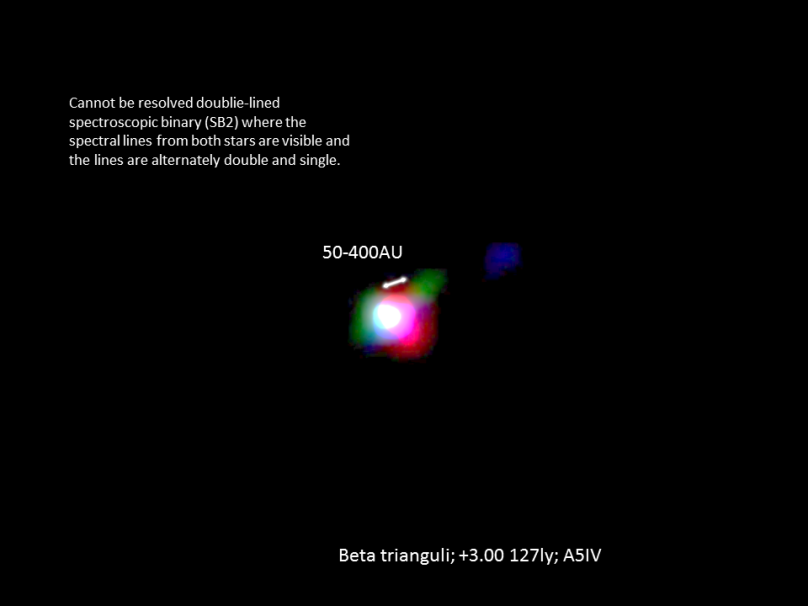 Beta Trianguli is a double-lined spectroscopic binary star system in the constellation Triangulum, and it is the brightest star in the constellation. The binary members are separated by a distance of less than 5 AU. Beta Trianguli emits infrared radiation at 100k blackbody temp explained by a circumbinary dust ring, thought to extend 50 to 400 AU away from the stars.
Beta Trianguli is a double-lined spectroscopic binary star system in the constellation Triangulum, and it is the brightest star in the constellation. The binary members are separated by a distance of less than 5 AU. Beta Trianguli emits infrared radiation at 100k blackbody temp explained by a circumbinary dust ring, thought to extend 50 to 400 AU away from the stars.
 Pockets of spruce trees jutting out from dunes are trails of dark basaltic sand debris & erupting dust clouds that resemble dorsal fins.
Pockets of spruce trees jutting out from dunes are trails of dark basaltic sand debris & erupting dust clouds that resemble dorsal fins.
 αCMa Sirius of Canis Major, is a white star of apparent magnitude -1.46. It is 70x more luminous than our sun and is non-designated by the New Catalogue of Suspected Variable Stars, meaning it is not a variable star as it is photometrically more stable than our sun. It carries strong deep metallic lines of absorption heavier than helium such as iron, zinc, carbon, strontium, zirconium and deficiencies indeficiencies of others, such as calcium and scandium.
αCMa Sirius of Canis Major, is a white star of apparent magnitude -1.46. It is 70x more luminous than our sun and is non-designated by the New Catalogue of Suspected Variable Stars, meaning it is not a variable star as it is photometrically more stable than our sun. It carries strong deep metallic lines of absorption heavier than helium such as iron, zinc, carbon, strontium, zirconium and deficiencies indeficiencies of others, such as calcium and scandium.
 βDraconis, Rastaban, is an unstable cepheid variable does not vary in brightness as it fuses its helium core & turns into a large red giant. It is orbited by a dwarf companion once every four millennia.
βDraconis, Rastaban, is an unstable cepheid variable does not vary in brightness as it fuses its helium core & turns into a large red giant. It is orbited by a dwarf companion once every four millennia.
 Venus always seem like a gilt-edged asteroid seal impressed in sealing white wax laced on black parchment. Non perfect spherical & jaggedy.
Venus always seem like a gilt-edged asteroid seal impressed in sealing white wax laced on black parchment. Non perfect spherical & jaggedy.
 Kaus Australis, Epsilon Sagittarius, is a binary star system in the southern constellation of Sagittarius. The primary component of this system is an evolved class III giant star that has exhausted the supply of hydrogen at its core. The interferometry-measured angular diameter of this star is 1.44 mas (milliarcseconds) which, at its physical radius is about 6.8 times the sun’s radius. As of 2001, the secondary companion is located at an angular separation of 2.392 arcseconds from the primary. This is about a physical separation of 106 AU, which places it inside the debris disk. It is a main sequence star with about 95% of the mass of the Sun. This system presents an infrared toroid circumbinary disc orbiting a binary sys, proving planetesimal coagulation-continued evolution and scattered stuff around edge of disc and beyond. Possible sentient beings called Kaus Australians.
Kaus Australis, Epsilon Sagittarius, is a binary star system in the southern constellation of Sagittarius. The primary component of this system is an evolved class III giant star that has exhausted the supply of hydrogen at its core. The interferometry-measured angular diameter of this star is 1.44 mas (milliarcseconds) which, at its physical radius is about 6.8 times the sun’s radius. As of 2001, the secondary companion is located at an angular separation of 2.392 arcseconds from the primary. This is about a physical separation of 106 AU, which places it inside the debris disk. It is a main sequence star with about 95% of the mass of the Sun. This system presents an infrared toroid circumbinary disc orbiting a binary sys, proving planetesimal coagulation-continued evolution and scattered stuff around edge of disc and beyond. Possible sentient beings called Kaus Australians.
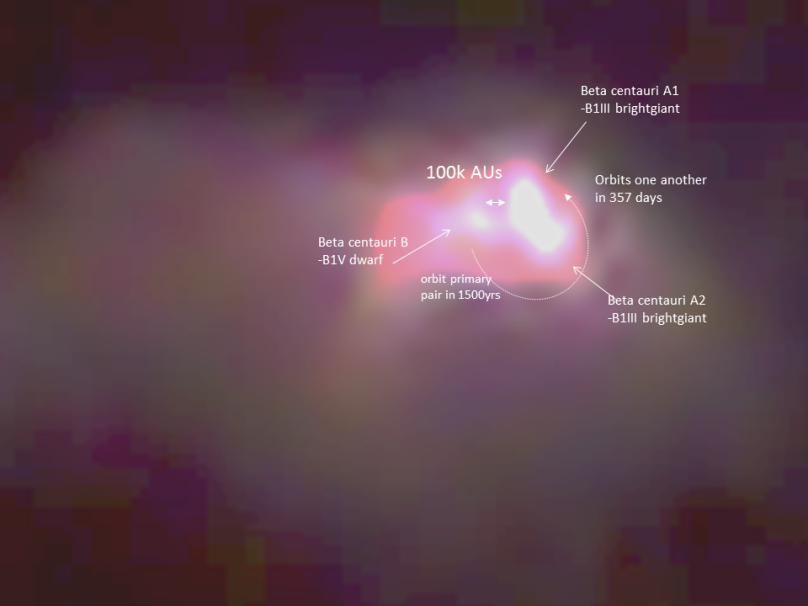 Hadar (Beta Centauri), is the second brightest in the southern constellation of Centaurus after Alpha Centauri. It is a triple star system of 2 blue white giant stars and one mainstream star. It is a Beta Cephei variable star with small rapid variations in brightness (0.01-0.3 mag) in 4.5hrs due to multiple pulsation and the unusual properties of iron at temperatures of 200,000K in their interiors.
Hadar (Beta Centauri), is the second brightest in the southern constellation of Centaurus after Alpha Centauri. It is a triple star system of 2 blue white giant stars and one mainstream star. It is a Beta Cephei variable star with small rapid variations in brightness (0.01-0.3 mag) in 4.5hrs due to multiple pulsation and the unusual properties of iron at temperatures of 200,000K in their interiors.
 Altair, Alpha Aquilae, is an alpha and brightest star of the constellation Aquila. It is currently in the G-cloud—a nearby accumulation of gas and dust known as an interstellar cloud. It is a white delta scuti variable, with its light curve periods that range between 0.8 and 1.5 hours in magnitudes of +0.003 to +0.9. Altair rotates rapidly with a velocity at the equator of 286 km/s at 9 hours a day, and therefore is flattened at the poles. Its equator is 20% greater than its polar diameter. In addition, there are several companions with the main star, making it altogether harder to resolve.
Altair, Alpha Aquilae, is an alpha and brightest star of the constellation Aquila. It is currently in the G-cloud—a nearby accumulation of gas and dust known as an interstellar cloud. It is a white delta scuti variable, with its light curve periods that range between 0.8 and 1.5 hours in magnitudes of +0.003 to +0.9. Altair rotates rapidly with a velocity at the equator of 286 km/s at 9 hours a day, and therefore is flattened at the poles. Its equator is 20% greater than its polar diameter. In addition, there are several companions with the main star, making it altogether harder to resolve.
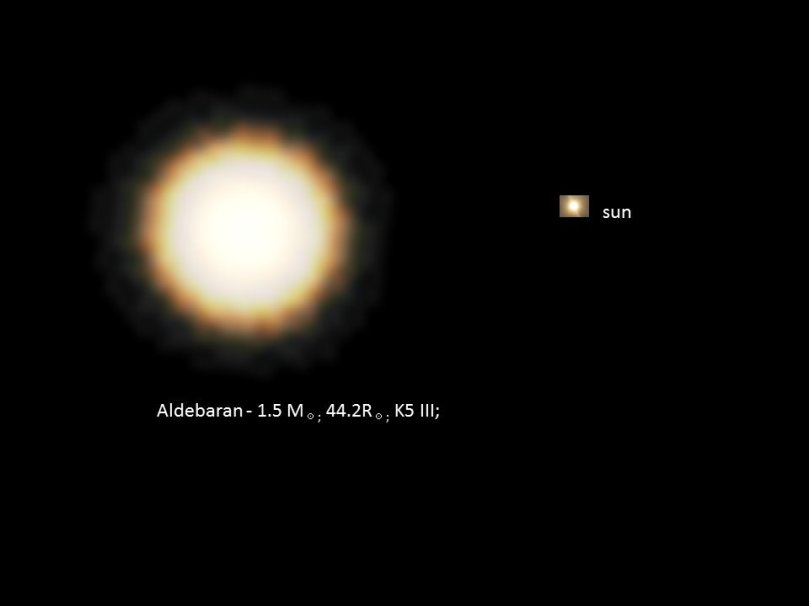 Aldebaran, αTauri, is an orange-hued giant star in a multiple star system in the constellation of Taurus, has B-F companions too close to measure. It is 65ly away from the sun with an apparent magnitude of +0.86 (+0.76 – +0.96) and is a slow irregular variable LB type with pulsations of +0.2 and exhibits no periodicity (slow changing light emissions.) The photosphere shows abundances of carbon, oxygen, and nitrogen that suggest the giant has gone through its first dredge-up and at the second dredge-up stage—a normality in the evolution of a star into the red giant branch during which materials from deep within the star are brought up to the surface by convection. With its slow rotation at 643 days, Aldebaran lacks electromagnetic dynamo needed to generate a corona and hence is not a source of X-ray emission.
Aldebaran, αTauri, is an orange-hued giant star in a multiple star system in the constellation of Taurus, has B-F companions too close to measure. It is 65ly away from the sun with an apparent magnitude of +0.86 (+0.76 – +0.96) and is a slow irregular variable LB type with pulsations of +0.2 and exhibits no periodicity (slow changing light emissions.) The photosphere shows abundances of carbon, oxygen, and nitrogen that suggest the giant has gone through its first dredge-up and at the second dredge-up stage—a normality in the evolution of a star into the red giant branch during which materials from deep within the star are brought up to the surface by convection. With its slow rotation at 643 days, Aldebaran lacks electromagnetic dynamo needed to generate a corona and hence is not a source of X-ray emission.
 Mystery lights appear over Tokyo triggering earthquake. Taking a dump of astrofilth bolide apparent mag -8 on our backyard & disappearing in quantum leaps.
Mystery lights appear over Tokyo triggering earthquake. Taking a dump of astrofilth bolide apparent mag -8 on our backyard & disappearing in quantum leaps.
 30 Cygni of Cygnus constellation is a white giant star with an apparent magnitude +4.83 and approximately 610 light years away. It is six arc-minutes from 31 Cygni A, and seven arc-minutes from 31 Cygni B.
30 Cygni of Cygnus constellation is a white giant star with an apparent magnitude +4.83 and approximately 610 light years away. It is six arc-minutes from 31 Cygni A, and seven arc-minutes from 31 Cygni B.
31 Cygni pair is also known as ο1 Cygni. It is an eclipsing binary of apparent magnitude +3.73 and 3.89 over a period of ten years. The component stars are an orange supergiant of spectral type K4Iab and a blue-white star likely to be of spectral type of B4IV-V. 31Cygni is an algol variable type semidetached eclipsing binary as the giant fills its roche lobe but the B dwarf does not fill its roche lobe, and they aren’t close but have regular periods.
 Eta Ursae Majoris, Alkaid, is the most eastern star in the Plough asterism but it is not a member of the Ursa Major moving group. It has an effective temperature of about 16,823K for a hot blue-white hue of a B-type X-ray emitter star. Its distance from the sun is about 100ly.
Eta Ursae Majoris, Alkaid, is the most eastern star in the Plough asterism but it is not a member of the Ursa Major moving group. It has an effective temperature of about 16,823K for a hot blue-white hue of a B-type X-ray emitter star. Its distance from the sun is about 100ly.
 Zeta Scorpii is shared by two optical double stars in the constellation Scorpius. ζ1 Scorpii is a LBV star, massively unstable supergiant with unpredictable spectroscopic and photometric variation with periodic outbursts and eruptions. ζ1 is 5,700 light-years away and probably an outlying member of open star cluster NGC 6231. ζ2 is a line of sight coincidence to ζ1, and it is much closer to the Sun, but is not related to NGC 6231.
Zeta Scorpii is shared by two optical double stars in the constellation Scorpius. ζ1 Scorpii is a LBV star, massively unstable supergiant with unpredictable spectroscopic and photometric variation with periodic outbursts and eruptions. ζ1 is 5,700 light-years away and probably an outlying member of open star cluster NGC 6231. ζ2 is a line of sight coincidence to ζ1, and it is much closer to the Sun, but is not related to NGC 6231.
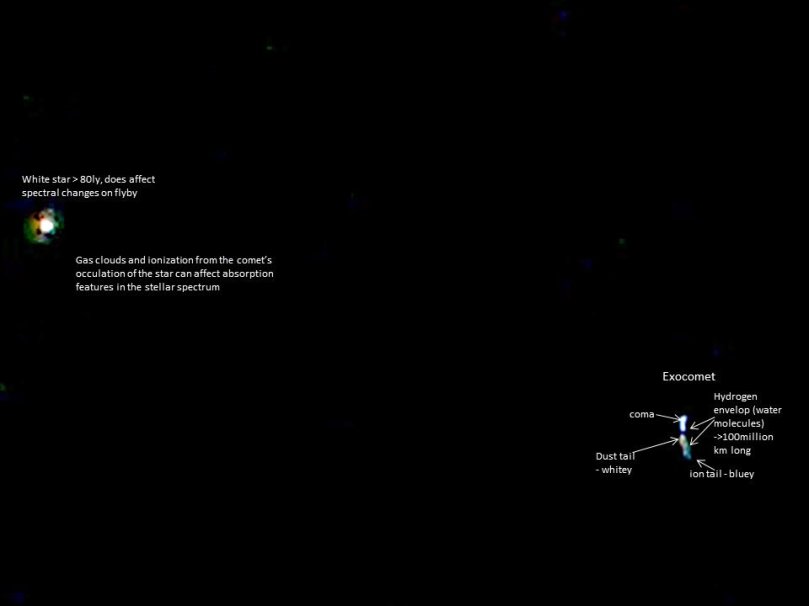 Most meteoroids contain nickel-iron. Some contain particle-like grit-cosmic dust from accretion of debris ejection/collision impacts.
Most meteoroids contain nickel-iron. Some contain particle-like grit-cosmic dust from accretion of debris ejection/collision impacts.
 The bright areas show hot dense gas that is captured by the magnetic fields of the doublet. The dark strips aid these hot gases to escape.
The bright areas show hot dense gas that is captured by the magnetic fields of the doublet. The dark strips aid these hot gases to escape.
 Green stars exist when it emits peak temp & radiation at green wavelength 492-577nm, but perceived as white due to all color mixture.
Green stars exist when it emits peak temp & radiation at green wavelength 492-577nm, but perceived as white due to all color mixture.
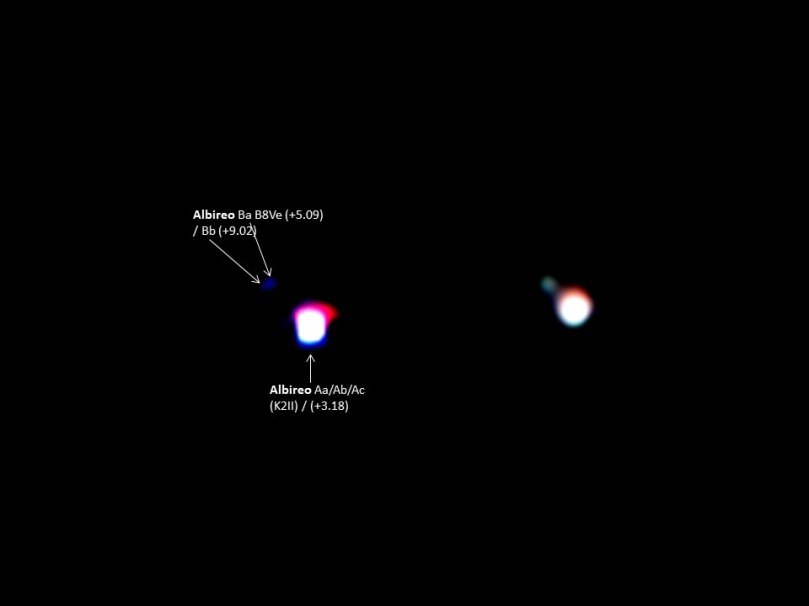 BetaCygni, Albireo A&B of Cygni constellation, separated by 35″ is considered an optical double rather than a visual binary luminous enough to be seen with a bino. If they were true binaries, their orbital period would be at least 100,000 years. Albireo A is a triplet, B a doublet, unveil as a quintuple. B is a fast-rotating with an equatorial rotational velocity at 250 km/s.
BetaCygni, Albireo A&B of Cygni constellation, separated by 35″ is considered an optical double rather than a visual binary luminous enough to be seen with a bino. If they were true binaries, their orbital period would be at least 100,000 years. Albireo A is a triplet, B a doublet, unveil as a quintuple. B is a fast-rotating with an equatorial rotational velocity at 250 km/s.
 NGC6231, Northern Jewel Box, is located in the Crux constellation. It is an open cluster near to Zeta Scorpii. Approaching us at 22 km/s from 5900ly, its magnitude is +2.6, with a visual distance at 15′. The cluster belongs to the young Scorpius OB1 association in the neighboring Sagittarius Arm of the Milky Way.
NGC6231, Northern Jewel Box, is located in the Crux constellation. It is an open cluster near to Zeta Scorpii. Approaching us at 22 km/s from 5900ly, its magnitude is +2.6, with a visual distance at 15′. The cluster belongs to the young Scorpius OB1 association in the neighboring Sagittarius Arm of the Milky Way.
 The M45 Pleiades is an open cluster located in the Taurus constellation containing middle age hot B-type stars formed within the last 100myr. The bluish reflective dust clouds are bypassing & unrelated to the clusters since the dust would have been long dispersed by radiation pressure at the earlier stages. Some component stars will be ejected due to closer encounters with others; some will be stripped by tidal gravitational forces; molecular clouds & spiral arms of the milky way will disperse this star cluster in 250myr.
The M45 Pleiades is an open cluster located in the Taurus constellation containing middle age hot B-type stars formed within the last 100myr. The bluish reflective dust clouds are bypassing & unrelated to the clusters since the dust would have been long dispersed by radiation pressure at the earlier stages. Some component stars will be ejected due to closer encounters with others; some will be stripped by tidal gravitational forces; molecular clouds & spiral arms of the milky way will disperse this star cluster in 250myr.
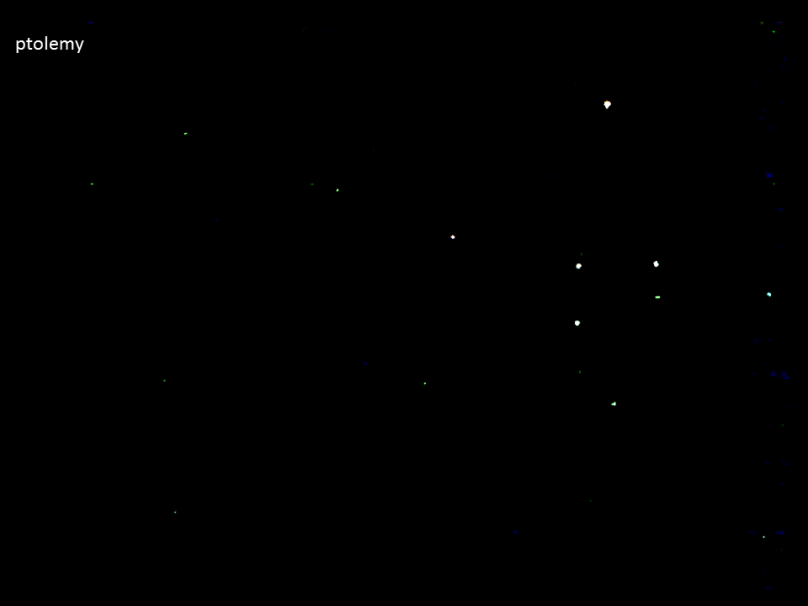 M7 open cluster, Ptolemy, is found in the constellation of Scorpius. The cluster is easily detectable, which is close to the “stinger” of Scorpius. It is the southernmost Messier object with a declination of -34.8°. is 220myr, lies 980ly away (diameter of 25ly) at apparent mag +3.3 stretching 1.3°. It is approaching us at 15 km/s. The stars do not leave its cluster. With a declination of -34.8°, it is the southernmost Messier object which the stars contain a similar abundance of elements other than hydrogen and helium.
M7 open cluster, Ptolemy, is found in the constellation of Scorpius. The cluster is easily detectable, which is close to the “stinger” of Scorpius. It is the southernmost Messier object with a declination of -34.8°. is 220myr, lies 980ly away (diameter of 25ly) at apparent mag +3.3 stretching 1.3°. It is approaching us at 15 km/s. The stars do not leave its cluster. With a declination of -34.8°, it is the southernmost Messier object which the stars contain a similar abundance of elements other than hydrogen and helium.
 Mizar, ζ Ursae Majoris, is a 2nd magnitude star of the Big Dipper asterism in the constellation of Ursa Major. It forms a well-known naked eye optical double star Mizar A and B, each with its own spectroscopic binary understood to be identical. Mizar A are Ap stars that show abundances of strontium and silicon. Mizar B is a single-lined Am star, with unusually strong lines of some metals based on the calcium k lines and other metals like strontium. Together with the fainter star Alcor at 12 arc mins from Mizar, Alcor has an apparent mag of +3.99 of spectral type A5V.
Mizar, ζ Ursae Majoris, is a 2nd magnitude star of the Big Dipper asterism in the constellation of Ursa Major. It forms a well-known naked eye optical double star Mizar A and B, each with its own spectroscopic binary understood to be identical. Mizar A are Ap stars that show abundances of strontium and silicon. Mizar B is a single-lined Am star, with unusually strong lines of some metals based on the calcium k lines and other metals like strontium. Together with the fainter star Alcor at 12 arc mins from Mizar, Alcor has an apparent mag of +3.99 of spectral type A5V.
 αCarinae, Canopus, is the brightest star in the Carina constellation and the second brightest star in the night sky. It is a hydrogen fusing white bright giant at apparent magnitude -0.74, 60000x more luminous than our ☼. It sheds into a planetary nebula at the end of its life. A relative cool red M-dwarf star lies south 6.2ly. It is a source of X-rays probably produced by its corona stimulated by fast rotation and strong convection percolating through the star’s outer layers. It is not known to be a metal rich star as it is not a reddish giant.
αCarinae, Canopus, is the brightest star in the Carina constellation and the second brightest star in the night sky. It is a hydrogen fusing white bright giant at apparent magnitude -0.74, 60000x more luminous than our ☼. It sheds into a planetary nebula at the end of its life. A relative cool red M-dwarf star lies south 6.2ly. It is a source of X-rays probably produced by its corona stimulated by fast rotation and strong convection percolating through the star’s outer layers. It is not known to be a metal rich star as it is not a reddish giant.
 𝛿Cygni, Al-fawaris is a trinary system that lies in the Cygnus constellation at a distance of 165 light years and consists of two stars quite close together and one much farther out. This sort of common configuration lends stability. If all the stars interact, the dwarf is soon ejected. As seen from Earth, the entire triple star system shines at a combined apparent magnitude of 2.86. Its entire luminosity which at some viewpoint near to the system is approximately 8000 fullmoons.
𝛿Cygni, Al-fawaris is a trinary system that lies in the Cygnus constellation at a distance of 165 light years and consists of two stars quite close together and one much farther out. This sort of common configuration lends stability. If all the stars interact, the dwarf is soon ejected. As seen from Earth, the entire triple star system shines at a combined apparent magnitude of 2.86. Its entire luminosity which at some viewpoint near to the system is approximately 8000 fullmoons.
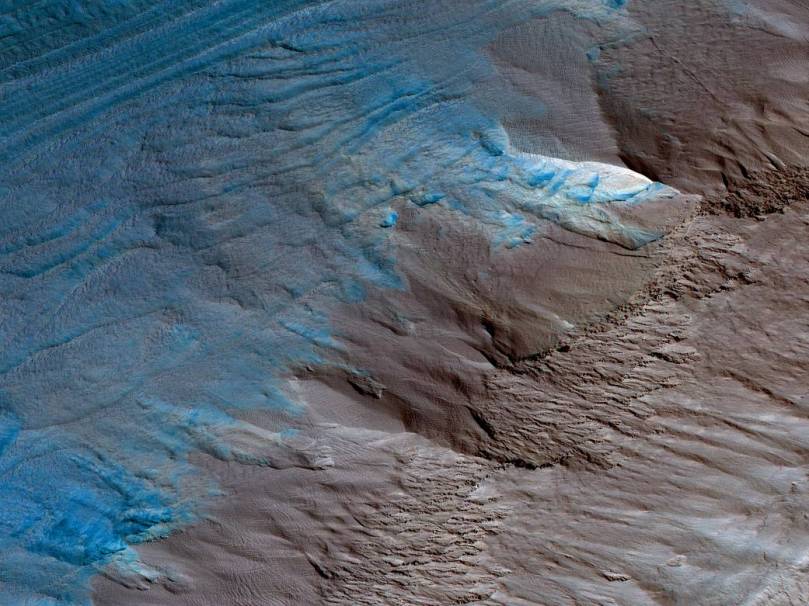 A skewed view from the Mars Reconnaissance Orbiter of the edge of the icy layers on the South Pole, has a reptile-eat-reptile morphology.
A skewed view from the Mars Reconnaissance Orbiter of the edge of the icy layers on the South Pole, has a reptile-eat-reptile morphology.
 Venus in its 1/2-3/4 D-reversed shape at app diameter 24″, apparent magnitude -4. Position of this Venus image is at point A while it is viewed from earth.
Venus in its 1/2-3/4 D-reversed shape at app diameter 24″, apparent magnitude -4. Position of this Venus image is at point A while it is viewed from earth.
 Alpha Scorpii, Antares is a red luminous supergiant, and is the autumnal equinox royal star of Persia. It is a slow irregular variable star that ranges in brightness from +0.6 to +1.6, radially pulsating to alter its surface radius by 20% or 165R☉, in a given poor periodicity of 1,733 days in slow changing light emissions. Depending on how much matter is ejected by A, which dims the luminosity (secondary minimum magnitude) and affects the spectral lines of Antares B. Will go supernova 2 (< 20M☉) and collapse into a neutron star.
Alpha Scorpii, Antares is a red luminous supergiant, and is the autumnal equinox royal star of Persia. It is a slow irregular variable star that ranges in brightness from +0.6 to +1.6, radially pulsating to alter its surface radius by 20% or 165R☉, in a given poor periodicity of 1,733 days in slow changing light emissions. Depending on how much matter is ejected by A, which dims the luminosity (secondary minimum magnitude) and affects the spectral lines of Antares B. Will go supernova 2 (< 20M☉) and collapse into a neutron star.
 Citizens in South Western China were treated to a spectacular sky light show thanks to a bolide celebrating the mid autumn festival.
Citizens in South Western China were treated to a spectacular sky light show thanks to a bolide celebrating the mid autumn festival.
Thanks to a bolide celebrating the mid autumn festival citizens in South Western China were treated to a spectacular sky light show.
 Epsilon Lyrae, The Double Double, is a multiple star system in the constellation of Lyra. Both pairs ε1(south) and ε2(north), are split into binaries. ε1’s pair separates 2.6″; ε2’s pair at 2.3″. Easily resolvable with binoculars. An observer standing at one pair would see the other pair shining with the light of a quarter Moon, less than a degree away from each other.
Epsilon Lyrae, The Double Double, is a multiple star system in the constellation of Lyra. Both pairs ε1(south) and ε2(north), are split into binaries. ε1’s pair separates 2.6″; ε2’s pair at 2.3″. Easily resolvable with binoculars. An observer standing at one pair would see the other pair shining with the light of a quarter Moon, less than a degree away from each other.
 The binary star system of Alpha Centauri AB, or Rigil Kentaurus AB located in the Centaurus constellation, has a spectral yellow-orange G2V / K1V class. It is the nearest star system to earth at -0.27 apparent magnitude some 4.37ly away. The two stars apparent angular separation at a sidereal orbital period of 79.9 years at a mean distance of 11.2 AU (1.65B km – between saturn to sun) means that the two stars cannot be resolved with the naked eye.
The binary star system of Alpha Centauri AB, or Rigil Kentaurus AB located in the Centaurus constellation, has a spectral yellow-orange G2V / K1V class. It is the nearest star system to earth at -0.27 apparent magnitude some 4.37ly away. The two stars apparent angular separation at a sidereal orbital period of 79.9 years at a mean distance of 11.2 AU (1.65B km – between saturn to sun) means that the two stars cannot be resolved with the naked eye.
 αCentauri AB is a visual binary system located in the Centaurus constellation of the southern hemisphere. αCen A has 1.1x the mass and 1.519x the luminosity of the Sun, while αCen B is smaller and cooler, at 0.907x the Sun’s mass and 0.445x its luminosity. The light curve of B varies on a short time scale and has been at least one observed flare, make it photometrically stable like our sun. A is more luminous but emits less X-ray band energy than B. It may be easily resolved with a telescope.
αCentauri AB is a visual binary system located in the Centaurus constellation of the southern hemisphere. αCen A has 1.1x the mass and 1.519x the luminosity of the Sun, while αCen B is smaller and cooler, at 0.907x the Sun’s mass and 0.445x its luminosity. The light curve of B varies on a short time scale and has been at least one observed flare, make it photometrically stable like our sun. A is more luminous but emits less X-ray band energy than B. It may be easily resolved with a telescope.
 αGeminorum, Castor, is a double star of both white class main sequence stars in the Gemini constellation, with 4 further red dwarfs known as BY Draconis variables (FlareStars) with less than +0.5 magnitude variation over a quasiperiod (no precise periodicity) as they pulsate non-radially from 1 period to next. Although there are 6 main stars, other nearby stars are further condensed in the multiples as eclipsing binaries.
αGeminorum, Castor, is a double star of both white class main sequence stars in the Gemini constellation, with 4 further red dwarfs known as BY Draconis variables (FlareStars) with less than +0.5 magnitude variation over a quasiperiod (no precise periodicity) as they pulsate non-radially from 1 period to next. Although there are 6 main stars, other nearby stars are further condensed in the multiples as eclipsing binaries.
 δPersei of Perseus constellation, is a white optical double maybe triple which had evolved into a giant after exhausting the hydrogen at its core. Observation with the IRAS shows an extended, ring-like or bubble feature generated by stellar wind or radiation pressure from the stars. It is a member of the Alpha Persei cluster or Melotte 20.
δPersei of Perseus constellation, is a white optical double maybe triple which had evolved into a giant after exhausting the hydrogen at its core. Observation with the IRAS shows an extended, ring-like or bubble feature generated by stellar wind or radiation pressure from the stars. It is a member of the Alpha Persei cluster or Melotte 20.
 Fomalhaut, Alpha Piscis Austrini is a multiple star system in Piscis Austrinus. Its primary star is a class A3V white star on the main sequence approximately 25 light-years away from the Sun. The rastered image shows binary companions B and C (TW Pisces Austrini / LP 876-10.) Fomalhaut is surrounded by several debris disks. The inner dark blue disk is a high-carbon small-grain ash disk clustering at 0.1 AU from the stars. Next is a lighter blue disk of larger particles 0.4-1 AU of the star. The outermost disk is at a radial distance of 133 AU.
Fomalhaut, Alpha Piscis Austrini is a multiple star system in Piscis Austrinus. Its primary star is a class A3V white star on the main sequence approximately 25 light-years away from the Sun. The rastered image shows binary companions B and C (TW Pisces Austrini / LP 876-10.) Fomalhaut is surrounded by several debris disks. The inner dark blue disk is a high-carbon small-grain ash disk clustering at 0.1 AU from the stars. Next is a lighter blue disk of larger particles 0.4-1 AU of the star. The outermost disk is at a radial distance of 133 AU.
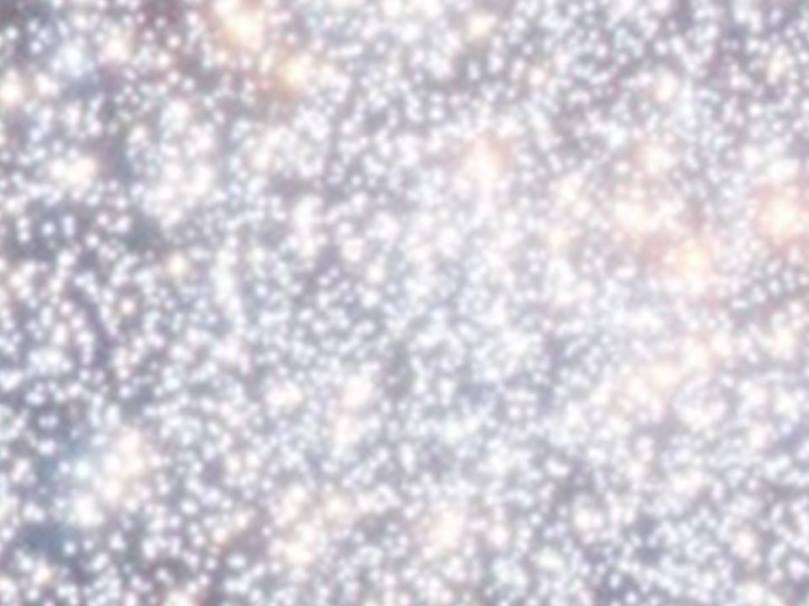 Globular clusters are a spherical collection of stars that orbits a galactic core as a satellite. Globular clusters are very tightly bound by gravity, which gives them their spherical shapes and relatively high stellar densities toward their centers. When you zoom in for a closer look, the stars and its adjacent non-baryonic dark energy resemble densely packed well-defined patterned swarms of astrofilth, which is why i call them fake lights.
Globular clusters are a spherical collection of stars that orbits a galactic core as a satellite. Globular clusters are very tightly bound by gravity, which gives them their spherical shapes and relatively high stellar densities toward their centers. When you zoom in for a closer look, the stars and its adjacent non-baryonic dark energy resemble densely packed well-defined patterned swarms of astrofilth, which is why i call them fake lights.
 π Scorpii is a triple star system in the constellation Scorpius. It has a combined apparent magnitude of +2.9. The main components of this system form an eclipsing binary of the Beta Lyrae variable type. The eclipses are smooth and hard to tell as the flow of mass into each other is so huge it envelopes the whole system in a common atmosphere.
π Scorpii is a triple star system in the constellation Scorpius. It has a combined apparent magnitude of +2.9. The main components of this system form an eclipsing binary of the Beta Lyrae variable type. The eclipses are smooth and hard to tell as the flow of mass into each other is so huge it envelopes the whole system in a common atmosphere.
The two stars are rotating rapidly, with projected rotational velocities of 108 and 87 km/s respectively with orbital periods of 1.57 days and they are separated by an estimated distance of only 15 solar radiia long a circular orbit.
They are so close that their shapes are heavily distorted into a combined ellipsoidal form by mutual gravitation forces as there are extensive mass flows from one component to the other.
 α Lyrae, Vega, of Lyra constellation, is the fifth brightest star in the night sky and the second brightest in the northern hemisphere after Arcturus. It is a blue tinged main sequence white star of spectral type A0V that is fusing hydrogen to helium with a life span of 545myr. It is a fast rotating star at 236km/s, hence the oblate nature of the star means that the pole is considerably brighter than the equator. As it is seen pole-on rather than at equator sight, its apparent luminosity from Earth is notably higher.
α Lyrae, Vega, of Lyra constellation, is the fifth brightest star in the night sky and the second brightest in the northern hemisphere after Arcturus. It is a blue tinged main sequence white star of spectral type A0V that is fusing hydrogen to helium with a life span of 545myr. It is a fast rotating star at 236km/s, hence the oblate nature of the star means that the pole is considerably brighter than the equator. As it is seen pole-on rather than at equator sight, its apparent luminosity from Earth is notably higher.
Vega is a Delta Scuti variable type with a period of 0.107 days that exhibits brightness fluctuations of +0.20. The radial velocity indicates that the star is moving towards the earth’s line of sight at doppler’s redshift’s (indicate moving away) measurements of −13.9 km/s (minus indicating moving closer). This main sequence star that is fusing hydrogen to helium in its core with a lifetime of one billion year with the current lifespan at about 455 million years. It will become a red giant and shed its mass to become a white dwarf.
 κappa Boötis, Asellus Tertius is a double star in the constellation Boötes. The components are separated by an angular distance of 13.5 arcsec viewable in a small telescope. κ1 Boötis is a spectroscopic binary. κ2 Boötis is classified as a Delta Scuti type variable star with a period of 1.08 hours and its brightness varies with a difference of +0.08. Brown dwarfs are substellar objects that occupy the mass range between the heaviest gas giant planets and the lightest stars of appx 13 to 75–80 Jupiter masses or approximately 2.5×10_28 kg to about 1.5×10_29 kg. Below this range are the sub-brown dwarfs, and above it are the lightest red dwarfs (M9 V). Brown dwarfs are not massive enough to sustain nuclear fusion of ordinary hydrogen to helium in their cores. They are, however, thought to fuse deuterium.
κappa Boötis, Asellus Tertius is a double star in the constellation Boötes. The components are separated by an angular distance of 13.5 arcsec viewable in a small telescope. κ1 Boötis is a spectroscopic binary. κ2 Boötis is classified as a Delta Scuti type variable star with a period of 1.08 hours and its brightness varies with a difference of +0.08. Brown dwarfs are substellar objects that occupy the mass range between the heaviest gas giant planets and the lightest stars of appx 13 to 75–80 Jupiter masses or approximately 2.5×10_28 kg to about 1.5×10_29 kg. Below this range are the sub-brown dwarfs, and above it are the lightest red dwarfs (M9 V). Brown dwarfs are not massive enough to sustain nuclear fusion of ordinary hydrogen to helium in their cores. They are, however, thought to fuse deuterium.
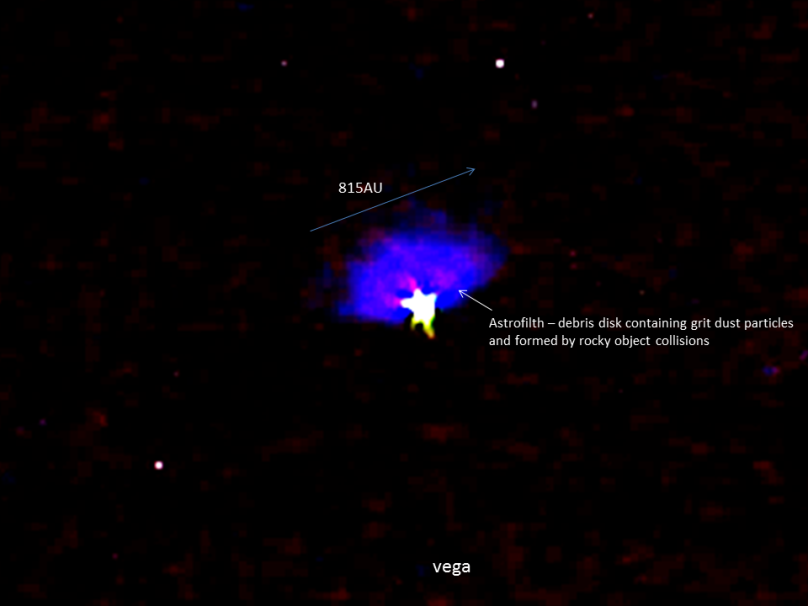 This middle-resolution image of the dust around Vega shows its debris disk to extend out to 330AU, 543AU and 815AU. The layers of larger wider disks were found to be circular and free of clumps with dust particles at 1–50 μm. (0.005cm) Production of the dust would require collisions between asteroids and other rock objects within a population corresponding to the Kuiper Belt. Thus the dust is more likely created by a debris disk around Vega, rather than from a protoplanetary disk of star formation. Excess infrared flux coming from Vega and its surroundings was measured at wavelengths of 25, 60, and 100 μm, at an angular radius quite close to the star. possibly 80AU. It was proposed that this infrared radiation came from a field of orbiting particles with a millimeter dimension as anything smaller would be removed by radiation pressure or sucked into the star.
This middle-resolution image of the dust around Vega shows its debris disk to extend out to 330AU, 543AU and 815AU. The layers of larger wider disks were found to be circular and free of clumps with dust particles at 1–50 μm. (0.005cm) Production of the dust would require collisions between asteroids and other rock objects within a population corresponding to the Kuiper Belt. Thus the dust is more likely created by a debris disk around Vega, rather than from a protoplanetary disk of star formation. Excess infrared flux coming from Vega and its surroundings was measured at wavelengths of 25, 60, and 100 μm, at an angular radius quite close to the star. possibly 80AU. It was proposed that this infrared radiation came from a field of orbiting particles with a millimeter dimension as anything smaller would be removed by radiation pressure or sucked into the star.
 ε Centauri is a blue tinge white star in the southern constellation of Centaurus. Distance is around 430 light-years from Earth. ε Centauri is a Beta Cepheid variable type with a primary period of 4 hours, completing 6 cycles per day. During each cycle, the brightness of the star varies from apparent magnitude +2.29 to +2.31. It is a young star of 16 myr.
ε Centauri is a blue tinge white star in the southern constellation of Centaurus. Distance is around 430 light-years from Earth. ε Centauri is a Beta Cepheid variable type with a primary period of 4 hours, completing 6 cycles per day. During each cycle, the brightness of the star varies from apparent magnitude +2.29 to +2.31. It is a young star of 16 myr.
 Solar rotation varies with latitude because the Sun is composed of gaseous plasma that travels at different rates thought to be fastest at the equator and decrease as latitude increases. At the equator the solar rotation period is 24 days relative to the fixed stars. The poles will take about 38 days.
Solar rotation varies with latitude because the Sun is composed of gaseous plasma that travels at different rates thought to be fastest at the equator and decrease as latitude increases. At the equator the solar rotation period is 24 days relative to the fixed stars. The poles will take about 38 days.
 Upsilon Scorpii, Lesath, is a B2 IV star of apparent magnitude +2.7 located in the “stinger” of the Scorpius constellation. It is 580ly away. There is some suggestion that it may have a companion, and with a mass 10 times solar, and probably turn into a massive neon-oxygen white dwarf.
Upsilon Scorpii, Lesath, is a B2 IV star of apparent magnitude +2.7 located in the “stinger” of the Scorpius constellation. It is 580ly away. There is some suggestion that it may have a companion, and with a mass 10 times solar, and probably turn into a massive neon-oxygen white dwarf.
 Gamma Draconis or Eltanin of Draco constellation, is an evolved giant star with a stellar classification of K5 III. It has 72% more mass than the Sun with an effective temperature of 3,930K, much cooler than the Sun giving Eltanin an orange-hued glow. It may have a physical red dwarf companion separated by about 1000 AU.
Gamma Draconis or Eltanin of Draco constellation, is an evolved giant star with a stellar classification of K5 III. It has 72% more mass than the Sun with an effective temperature of 3,930K, much cooler than the Sun giving Eltanin an orange-hued glow. It may have a physical red dwarf companion separated by about 1000 AU.
 Epsilon Ursae Majoris, also named Alioth, is the brightest star in the constellation of Ursa Major even though it is designated as Epsilon. It visual magnitude is +1.76 and is the thirty-first brightest star in the sky. Alioth, an Alpha 2 Canum Venaticorum variable star whose luminosity ranges from +0.01-0.1 over 1-160 days. The profiles of the spectral-magnetic field lines of Alioth vary due to disproportionate distribution of metals in the atmosphere varying brightness peaks.
Epsilon Ursae Majoris, also named Alioth, is the brightest star in the constellation of Ursa Major even though it is designated as Epsilon. It visual magnitude is +1.76 and is the thirty-first brightest star in the sky. Alioth, an Alpha 2 Canum Venaticorum variable star whose luminosity ranges from +0.01-0.1 over 1-160 days. The profiles of the spectral-magnetic field lines of Alioth vary due to disproportionate distribution of metals in the atmosphere varying brightness peaks.
 αCygni, Deneb, is the brightest star in the constellation of Cygnus. It spent much of its early life as an O-type blue main sequence star but it has now begun to cool & expand into a blue white supergiant. Most likely explode into a type IIP supernovae, with a period of slower decline than type IIL in their light curve followed by a normal decay. Deneb radial velocity changes in a periodic fashion, but no spectral features from a binary companion are seen. This star could explode as a yellow hypergiant or as a luminous blue variable (LBV), or it may become a Wolf-Rayet star before its supernova.
αCygni, Deneb, is the brightest star in the constellation of Cygnus. It spent much of its early life as an O-type blue main sequence star but it has now begun to cool & expand into a blue white supergiant. Most likely explode into a type IIP supernovae, with a period of slower decline than type IIL in their light curve followed by a normal decay. Deneb radial velocity changes in a periodic fashion, but no spectral features from a binary companion are seen. This star could explode as a yellow hypergiant or as a luminous blue variable (LBV), or it may become a Wolf-Rayet star before its supernova.
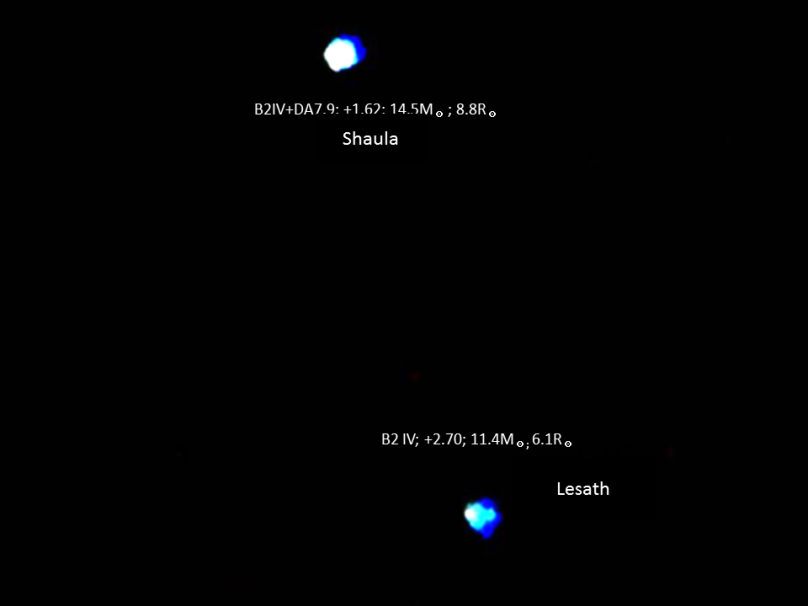 Shaula, λScorpii is located some 587ly from the Sun. It is actually a triple system. The primary star is a beta Cephei variable star with rapid brightness changes of about a hundredth of a magnitude. Lesath, υScorpii is 577ly is a binary pair in itself.
Shaula, λScorpii is located some 587ly from the Sun. It is actually a triple system. The primary star is a beta Cephei variable star with rapid brightness changes of about a hundredth of a magnitude. Lesath, υScorpii is 577ly is a binary pair in itself.
These 2 stars Shaula and lesath are fairly bright and close together at the “tail” end known as the scorpions stinger. They are not gravitationally bound and are expanding apart. From Lesath, Shaula would appear at magnitude -1.3, while from Shaula, Lesath would shine at magnitude zero +0.42.
 ζ Sagittarii, Ascella, is a binary-trinary star system and the third-brightest in Sagittarius. This system consists of 2 A type white giant and subgiant stars and 1 red dwarf in Sagittarius constellation, located 89ly from Earth. It is moving away from the Solar System with a radial velocity of +22 km/s. Some 1 million years ago, it came within only 7.5ly of the Sun. Its rotational velocity is 77km/s making it relatively ellipsoidal in shape and only a mean distance of 13.4AU orbiting at a 21 year period. The pair are close making them unstable due to mass accumulation of particles into a massive accretion disk blotting out its luminosity. Any period of eclipses would be typically smooth in its light curve to be able to discern any significant changes in brightness.
ζ Sagittarii, Ascella, is a binary-trinary star system and the third-brightest in Sagittarius. This system consists of 2 A type white giant and subgiant stars and 1 red dwarf in Sagittarius constellation, located 89ly from Earth. It is moving away from the Solar System with a radial velocity of +22 km/s. Some 1 million years ago, it came within only 7.5ly of the Sun. Its rotational velocity is 77km/s making it relatively ellipsoidal in shape and only a mean distance of 13.4AU orbiting at a 21 year period. The pair are close making them unstable due to mass accumulation of particles into a massive accretion disk blotting out its luminosity. Any period of eclipses would be typically smooth in its light curve to be able to discern any significant changes in brightness.
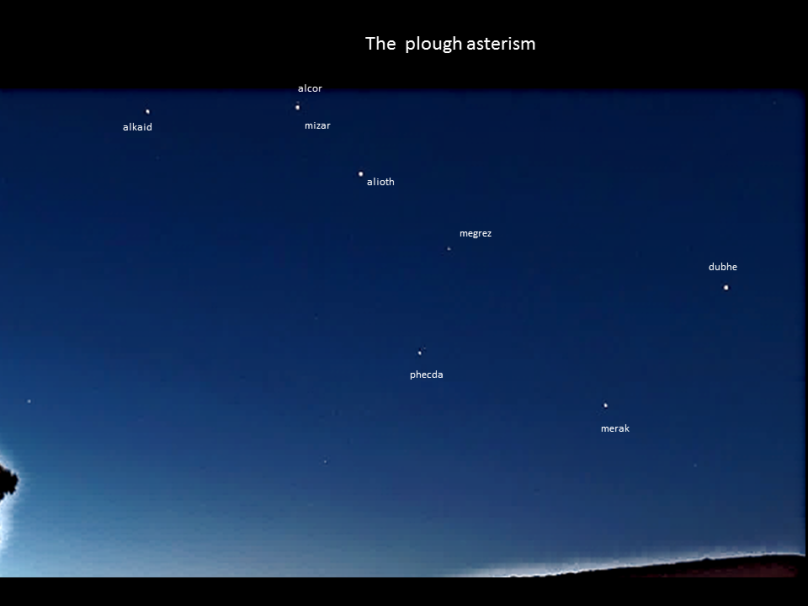 The Plough is an asterism consisting of seven bright stars belonging as part of the constellation of Ursa Major. 6 of them are of second magnitude and one, Megrez, of third magnitude, although it is the closest to earth of them all. Four define a bowl and three define a handle. It is recognized as a distinct grouping in many cultures. The North Star (Polaris)can be located by extending an imaginary line upwards through the two front stars, Merak and Dubhe.
The Plough is an asterism consisting of seven bright stars belonging as part of the constellation of Ursa Major. 6 of them are of second magnitude and one, Megrez, of third magnitude, although it is the closest to earth of them all. Four define a bowl and three define a handle. It is recognized as a distinct grouping in many cultures. The North Star (Polaris)can be located by extending an imaginary line upwards through the two front stars, Merak and Dubhe.
 ξ Ursae Majoris, is a visual binary star system comprising of 2 yellow G-type main-sequence stars separated by 1.2 arcsecs (10AU). ξ Ursae Majoris A is classified as an RS Canum Venaticorum type eruptive variable star. They are very close binary stars having active chromospheres which can cause large stellar spots, intense magnetic fields and sunspot activities.
ξ Ursae Majoris, is a visual binary star system comprising of 2 yellow G-type main-sequence stars separated by 1.2 arcsecs (10AU). ξ Ursae Majoris A is classified as an RS Canum Venaticorum type eruptive variable star. They are very close binary stars having active chromospheres which can cause large stellar spots, intense magnetic fields and sunspot activities.
 θScorpii, Sargas, is a binary star in the southern constellation of Scorpius. The visual magnitude of Sargas stands at +1.87, making it one of the more visible stars to the naked eye.
θScorpii, Sargas, is a binary star in the southern constellation of Scorpius. The visual magnitude of Sargas stands at +1.87, making it one of the more visible stars to the naked eye.
Eta Scorpii is a white-yellow F type subgiant that is evolving into a giant, together with Sargas, they form the backbone of the stinger tail of the scorpion.
 β Andromedae, a red giant class III evolving into a bright giant class II is the brightest in Andromeda constellation but due to its semiregular variable SRab status, it is classed under MIRA variables, i.e. poorly expressed periodicity of various cycles, pulsating from +2.01 to +2.10, a 0.9 units of extinction of gas and dust along the line of sight as well as periodic occultation.
β Andromedae, a red giant class III evolving into a bright giant class II is the brightest in Andromeda constellation but due to its semiregular variable SRab status, it is classed under MIRA variables, i.e. poorly expressed periodicity of various cycles, pulsating from +2.01 to +2.10, a 0.9 units of extinction of gas and dust along the line of sight as well as periodic occultation.
There would be an accreting disc as materials are ejected, gas layers are shed propelled by stellar winds and forming a planetary nebula prior to this bright giant becoming a white dwarf. The resultant nebula can give rise to protostars. With sufficient core temperature and density, collisions between the atoms in the protostar are vigorous and positive ionization occurs where permitted, the protons are then attracted and fuse to become a new star.
 Procyon is the alpha star in the constellation of Canis Minor. It is the 8th-brightest with a visual magnitude of +0.34. It is a binary AB star system, consisting of a white main-sequence star of spectral type F5 IV and a white dwarf companion of spectral type DQZ. Photometric measurements from the (WIRE) satellite showed evidence of “solar-like oscillations” and convection near Procyon, which can be used to indicate radii and mass of stars.
Procyon is the alpha star in the constellation of Canis Minor. It is the 8th-brightest with a visual magnitude of +0.34. It is a binary AB star system, consisting of a white main-sequence star of spectral type F5 IV and a white dwarf companion of spectral type DQZ. Photometric measurements from the (WIRE) satellite showed evidence of “solar-like oscillations” and convection near Procyon, which can be used to indicate radii and mass of stars.
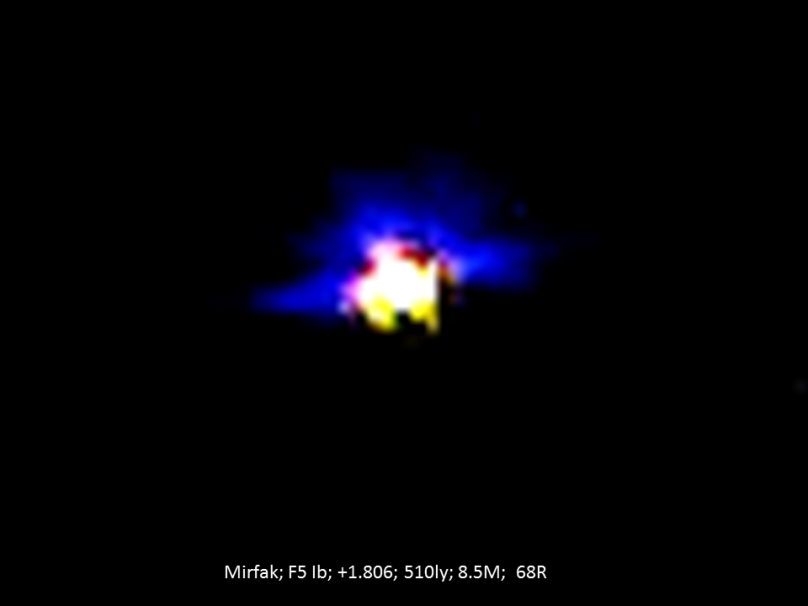 αPersei, Mirfak, is the brightest star in Perseus constellation of +1.8. It is a circumpolar star that never sets below the horizon due to its apparent proximity to the north celestial pole. Mirfak lies in the midst of Alpha Persei Cluster, and inside the region in which Cepheid variables are found. It is possible that Mirfak has at least one binary star orbiting it or at least one extrasolar planet in orbit around the star.
αPersei, Mirfak, is the brightest star in Perseus constellation of +1.8. It is a circumpolar star that never sets below the horizon due to its apparent proximity to the north celestial pole. Mirfak lies in the midst of Alpha Persei Cluster, and inside the region in which Cepheid variables are found. It is possible that Mirfak has at least one binary star orbiting it or at least one extrasolar planet in orbit around the star.
 Mercury’s orbital period around the Sun in 116 synodic days as an inferior planet can only be seen in the morning or evening sky and never exceeds 28° away from the Sun. Mercury is gravitationally locked with the Sun in a 3:2 spin-orbit resonance (3 rotations on its axis for every 2 solar orbits.
Mercury’s orbital period around the Sun in 116 synodic days as an inferior planet can only be seen in the morning or evening sky and never exceeds 28° away from the Sun. Mercury is gravitationally locked with the Sun in a 3:2 spin-orbit resonance (3 rotations on its axis for every 2 solar orbits.
Mercury exhibits phases just like Venus as viewed from Earth. It is new at inferior conjunction and full at superior conjunction which will not be visible from Earth on both these occasions due to obscuration by the Sun. Mercury is brightest as seen from Earth when it is at a full phase due to it greater illuminated area when full. The opposite is true for Venus, which appears brightest when it is a crescent since it is much closer to Earth than when full or gibbous.
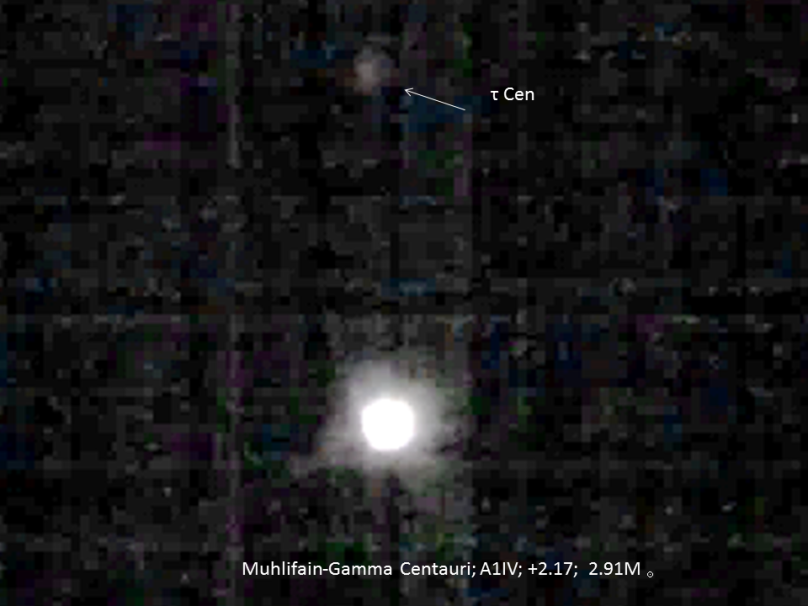 Gamma Centauri, Muhlifain is a A1V (A0III + A0III) spectral white double star in the southern constellation Centaurus. The double star has the same stellar spectral at combined visual magnitude +2.17, and in the process of becoming giants. The pair has an angular separation of 1.217 arcseconds, so is too close to resolve. Another star Tau Centauri is relatively close to Gamma, with an estimated separation of 1.72ly and it is a co-moving companion of Gamma Centauri.
Gamma Centauri, Muhlifain is a A1V (A0III + A0III) spectral white double star in the southern constellation Centaurus. The double star has the same stellar spectral at combined visual magnitude +2.17, and in the process of becoming giants. The pair has an angular separation of 1.217 arcseconds, so is too close to resolve. Another star Tau Centauri is relatively close to Gamma, with an estimated separation of 1.72ly and it is a co-moving companion of Gamma Centauri.
 The Milky Way is derived from the appearance from Earth as a band of light seen in the night sky. It appears as a band because its disk-shaped structure is viewed from within. It should contain 400 billion stars, although other galaxies may contain much more. The Milky Way is a barred spiral galaxy with a diameter of about 180000ly. We are about 26000ly from the Galactic bulge, on the inner edge of the Orion Arm, one of the spiral-shaped concentrations of gas and dust.
The Milky Way is derived from the appearance from Earth as a band of light seen in the night sky. It appears as a band because its disk-shaped structure is viewed from within. It should contain 400 billion stars, although other galaxies may contain much more. The Milky Way is a barred spiral galaxy with a diameter of about 180000ly. We are about 26000ly from the Galactic bulge, on the inner edge of the Orion Arm, one of the spiral-shaped concentrations of gas and dust.
Ever seen the milky way before? Nope. Oh, too bad for you, I performed well in my company to earn that incentive overseas trip.
 Saturn’s rotation at 9.87km/s causes it to be oblate spheroidal. Flat at poles & bulges at equator. Equatorial & polar radii differ by 10%. Due to counterclockwise circulating streams of material, dark and light bands are formed in the atmosphere. The darker bands are called belts which are lower in altitude and pressure, and the lighter bands are called zones, and are higher in altitude and pressure. They move parallel to the equator of the planet. Saturn’s belts and zones are thinner and less wispy, but much richer in depth in comparison to Jupiter’s. A visible light aurora tinge can be seen at the north pole.
Saturn’s rotation at 9.87km/s causes it to be oblate spheroidal. Flat at poles & bulges at equator. Equatorial & polar radii differ by 10%. Due to counterclockwise circulating streams of material, dark and light bands are formed in the atmosphere. The darker bands are called belts which are lower in altitude and pressure, and the lighter bands are called zones, and are higher in altitude and pressure. They move parallel to the equator of the planet. Saturn’s belts and zones are thinner and less wispy, but much richer in depth in comparison to Jupiter’s. A visible light aurora tinge can be seen at the north pole.
 αCrucis, located in the Crux constellation, is a multiple star system located 321 light-years from the Sun. It is part of the asterism known as the Southern Cross. Two components are visually distinguishable: αCrucis A and αCrucis B, in a 4 arcsec angular separation. Both are B-type stars. A cooler less luminous B-class star HR 4729 or αCrucis C lies 90 arcsecs away, suggesting gravitational bounding, together with further components D and E, as well as 6-7 other stars 2 arcmins away southwest.
αCrucis, located in the Crux constellation, is a multiple star system located 321 light-years from the Sun. It is part of the asterism known as the Southern Cross. Two components are visually distinguishable: αCrucis A and αCrucis B, in a 4 arcsec angular separation. Both are B-type stars. A cooler less luminous B-class star HR 4729 or αCrucis C lies 90 arcsecs away, suggesting gravitational bounding, together with further components D and E, as well as 6-7 other stars 2 arcmins away southwest.
 “NOBODY TURNS HIS BACK ON ME!” [Birdman screaming, as Duckman turns his back on him and hovers away using anti-gravity effects centered on its tripodal platform]. Birdman’s a fucking schizo after dabbling with sorcery on his enemies.
“NOBODY TURNS HIS BACK ON ME!” [Birdman screaming, as Duckman turns his back on him and hovers away using anti-gravity effects centered on its tripodal platform]. Birdman’s a fucking schizo after dabbling with sorcery on his enemies.
Birdman is envious of Duckman’s anti-gravity hovering ability as birdman relies on air pressure lift upon electromagnetic fields on the wings to fly instead of hover.
 Iota Ursae Majoris, Talitha Borealis, belongs to the northern circumpolar constellation of Ursa Major. This system is composed of two sets of yellow-white and red binary stars. The two binary systems orbit around each other once every 2,084 years.
Iota Ursae Majoris, Talitha Borealis, belongs to the northern circumpolar constellation of Ursa Major. This system is composed of two sets of yellow-white and red binary stars. The two binary systems orbit around each other once every 2,084 years.
The brighter component being the yellow-white subgiant is thought to have a spectroscopic companion in the form of a white dwarf with a mass of 0.3 M☉.
The other pair of companion binary are 9th or 10th magnitude stars, both of which are red dwarfs B and C with an orbital period of 39.7 years, and are separated by roughly 0.7 arcseconds (10 AU).
 Omicron Ursae Majoris, Muscida, is a yellow G-type star system in the northern circumpolar constellation which never sets below the horizon. An extrasolar planet, designated Omicron Ursae Majoris Ab, four times more massive than Jupiter, was found to be orbiting the primary.
Omicron Ursae Majoris, Muscida, is a yellow G-type star system in the northern circumpolar constellation which never sets below the horizon. An extrasolar planet, designated Omicron Ursae Majoris Ab, four times more massive than Jupiter, was found to be orbiting the primary.
 A single-lined spectroscopic binary system with an orbital period of 4.3 day, the primary component A, is an Am star with kA5hF0mF2 classification determined from Calcium K lines. Other metallic lines would be F2, and the hydrogen type as F0.
A single-lined spectroscopic binary system with an orbital period of 4.3 day, the primary component A, is an Am star with kA5hF0mF2 classification determined from Calcium K lines. Other metallic lines would be F2, and the hydrogen type as F0.
Zeta2 Lyrae is a double white-hued dim star 156ly from the Sun. It is moving closer to the Sun with a radial velocity of −25 km/s. This star has a stellar classification of F0 IVn, n suffix indicates “nebulous” lines caused by its rapid spinning at 212 km/s, possibly due to proximity of the 2 close stars gravitationally locked, giving an oblate shape with an equatorial bulge 30% larger than the polars. It is about 1.2 billion years old.
 Phi Sagittarii is a blue white star in the constellation of Sagittarius. distance of roughly 239 light-years from the Earth. Both represent stages in the evolution of a star after it has exhausted the hydrogen at its core. The blue white hue of energy is being radiated from the outer envelope at an effective temperature of 14,990 K. May have some dim optical companions.
Phi Sagittarii is a blue white star in the constellation of Sagittarius. distance of roughly 239 light-years from the Earth. Both represent stages in the evolution of a star after it has exhausted the hydrogen at its core. The blue white hue of energy is being radiated from the outer envelope at an effective temperature of 14,990 K. May have some dim optical companions.
 Theta Tauri is a double optical star in the Taurus constellation and a member of the Hyades open cluster. Both Theta Tauri A (orange giant K0III) and B (white giant A7III) are separated by 5.62 arcminutes, approximately 4ly, and are not gravitationally bound. Both Theta Tauri A and B in themselves are spectroscopic binaries.
Theta Tauri is a double optical star in the Taurus constellation and a member of the Hyades open cluster. Both Theta Tauri A (orange giant K0III) and B (white giant A7III) are separated by 5.62 arcminutes, approximately 4ly, and are not gravitationally bound. Both Theta Tauri A and B in themselves are spectroscopic binaries.
Theta Tauri B is a white star classified as a Delta Scuti type variable star and its brightness varies from a range of -+0.07 42 within a period of 0.0758 days (1.82 hours).
 Gamma Aquilae, Tarazed, is an orange star in the Aquila constellation roughly of 395ly in distance from the sun with an angular diameter of 7.271 mas. Being a single star as categorized, binary and triple systems can be formed through a fragmentation process. Studies show that accreting discs and gas shedding in the atmospheric layers of a bright giant or its companions can produce more star companions, typically of main sequence or brown dwarfs, by disc fragmentation and even form multiple systems. This requires a substantial amount of internal temperature and density in the core. Several low-mass components are ejected with less chance to accrete unlike the first generation of stars produced directly by fragmentation. Disc-generated companions form over an extended period of time, during the whole episode of collapse and accretion.
Gamma Aquilae, Tarazed, is an orange star in the Aquila constellation roughly of 395ly in distance from the sun with an angular diameter of 7.271 mas. Being a single star as categorized, binary and triple systems can be formed through a fragmentation process. Studies show that accreting discs and gas shedding in the atmospheric layers of a bright giant or its companions can produce more star companions, typically of main sequence or brown dwarfs, by disc fragmentation and even form multiple systems. This requires a substantial amount of internal temperature and density in the core. Several low-mass components are ejected with less chance to accrete unlike the first generation of stars produced directly by fragmentation. Disc-generated companions form over an extended period of time, during the whole episode of collapse and accretion.
The resultant triples or quads are typically not in a very hierarchical configuration, casting doubt on the survival of the system. This is no different from a duplicating system where each new star formation is further reduced in quality or size. Furthermore, such protostars comprise a small fraction of the total mass of the system, with the majority of the mass in the form of a gaseous envelope. The infall and outfall of this gaseous envelope can stabilize or destabilize the system.
 Alpha Lacertae of Lacerta constellation, is a white main sequence star in the constellation of Lacerta at visual magnitude of +3.777. The star has a visual companion, CCDM J22313+5017B, of visual magnitude +11.8, and thus is just an optical line-of-sight star and not a close companion as it is about 27 times farther at some 2700ly.
Alpha Lacertae of Lacerta constellation, is a white main sequence star in the constellation of Lacerta at visual magnitude of +3.777. The star has a visual companion, CCDM J22313+5017B, of visual magnitude +11.8, and thus is just an optical line-of-sight star and not a close companion as it is about 27 times farther at some 2700ly.
 Saiph, designated Kappa Orionis, is the sixth-brightest star in the constellation of Orion. A northern-hemisphere observer facing south would see it at the lower left of Orion. A suspected supergiant variable type whose brightness ranges from a magnitude of +2.09 to a magnitude of +1.986 with a typical change of 0.104 over its variable period 0hrs. The point of maximum brightness occurs when the pulsation of the star’s surface is smallest and hottest. It has exhausted the supply of hydrogen at its core with strong stellar winds and losing mass at the rate of the Sun’s mass every 1.1 million years.
Saiph, designated Kappa Orionis, is the sixth-brightest star in the constellation of Orion. A northern-hemisphere observer facing south would see it at the lower left of Orion. A suspected supergiant variable type whose brightness ranges from a magnitude of +2.09 to a magnitude of +1.986 with a typical change of 0.104 over its variable period 0hrs. The point of maximum brightness occurs when the pulsation of the star’s surface is smallest and hottest. It has exhausted the supply of hydrogen at its core with strong stellar winds and losing mass at the rate of the Sun’s mass every 1.1 million years.
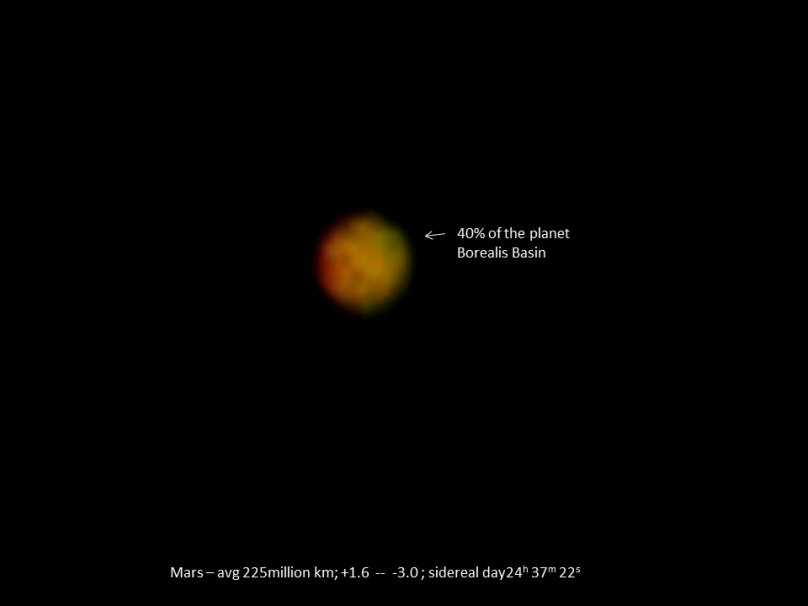 Referred to as the “Red Planet” because the reddish iron oxide prevalent on its surface gives it a reddish appearance that is distinctive among the other planetary bodies. It is a terrestrial planet with a thin atmosphere, having surface features reminiscent of a great war between the humanoids and reptilians. Its apparent magnitude reaches −2.91, surpassed only by Jupiter and Venus.
Referred to as the “Red Planet” because the reddish iron oxide prevalent on its surface gives it a reddish appearance that is distinctive among the other planetary bodies. It is a terrestrial planet with a thin atmosphere, having surface features reminiscent of a great war between the humanoids and reptilians. Its apparent magnitude reaches −2.91, surpassed only by Jupiter and Venus.
Olympus Mons is a shield mountain encapsulating the great reptilian combos of the azure dragon, black snake and tortoise. Its polar ice caps resemble a weave of “enchantment under the sea dance” of fishes heading into the inner hollow mars as the surface froze up. The North Polar Basin, more commonly known as the Borealis Basin, is a large basin in the northern hemisphere of Mars that covers 40% of the planet.
 Heliocentric parallax is the shift in the apparent position of a nearby star when seen from two different points on the Earth’s orbit. The parallax occurs as a result of the change in position relative to the Sun. We measure the angular shift in position of a star from E1 to E2.
Heliocentric parallax is the shift in the apparent position of a nearby star when seen from two different points on the Earth’s orbit. The parallax occurs as a result of the change in position relative to the Sun. We measure the angular shift in position of a star from E1 to E2.
HALF of the ANGULAR SHIFT is called the PARALLAX ANGLE (p).
*Formula D=1/p ;
D=distance in parsec ; P=parallax angle
The parallax angle of the earth orbit around sun as viewed from star of 2 parsec distance =
D = 1/p;
2 = 1/p;
P = 1/2;
P = 0.5 arcsec (parallax angle)
1 arcsecs for complete shift on both sides.
 α Lyncis is the brightest star in the northern constellation of Lynx. The only star in the constellation that has a Bayer designation, this star has exhausted hydrogen at its core and has expanded to 55 times the Sun’s radius, giving it an orange to red hue of a M type giant showing spectral lines of neutral metals and sodium elements.
α Lyncis is the brightest star in the northern constellation of Lynx. The only star in the constellation that has a Bayer designation, this star has exhausted hydrogen at its core and has expanded to 55 times the Sun’s radius, giving it an orange to red hue of a M type giant showing spectral lines of neutral metals and sodium elements.
It is a suspected small-amplitude red variable star that changes magnitude from +3.17 to +3.12, with a possible companion. This variability pattern typically occurs in stars that have developed an inert carbon core surrounded by a helium-fusing shell, and suggests that it is a a Mira-type variable, common within the stellar evolution of low to intermediate stars in the asymptotic giant branch region.
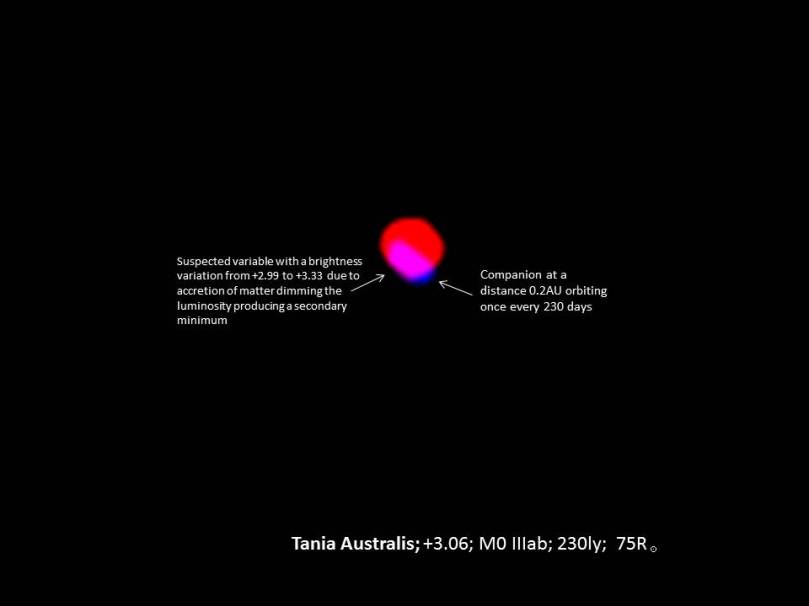 Mu Ursae Majoris, Tania Australis, is a binary giant star in the constellation of Ursa Major. It is currently in the red giant stage of stellar classification of M0 IIIab, brightening along the “red giant branch” with a contracting helium core to fuse to carbon. With an atmospheric effective temperature of 3899 K, it gives the star its orange-red hue. It is classified as a suspected variable star with a brightness variation from +2.99 to +3.33 due to accreting of matter and occultation from its main sequence blue dwarf (suspected) companion a mere 0.2 AU from the primary with an orbital period of 230 days.
Mu Ursae Majoris, Tania Australis, is a binary giant star in the constellation of Ursa Major. It is currently in the red giant stage of stellar classification of M0 IIIab, brightening along the “red giant branch” with a contracting helium core to fuse to carbon. With an atmospheric effective temperature of 3899 K, it gives the star its orange-red hue. It is classified as a suspected variable star with a brightness variation from +2.99 to +3.33 due to accreting of matter and occultation from its main sequence blue dwarf (suspected) companion a mere 0.2 AU from the primary with an orbital period of 230 days. The jovian planet of Jupiter’s jaggedy equatorial bands and zones taken using a small refractor under serious light pollution, which can often reduce the contrasty effects required to cast the important details such as moon transits and aurora glows. Jupiter can reach an apparent magnitude of −2.94, bright enough for its reflected light to cast shadows.
The jovian planet of Jupiter’s jaggedy equatorial bands and zones taken using a small refractor under serious light pollution, which can often reduce the contrasty effects required to cast the important details such as moon transits and aurora glows. Jupiter can reach an apparent magnitude of −2.94, bright enough for its reflected light to cast shadows.
This fifth planet is composed of 75% hydrogen with a quarter of its mass being helium although its upper atmosphere is 90% hydrogen and 10% helium by volume of gas molecules. Jupiter lacks a well-defined solid surface and due to its rapid rotation, the planet’s shape is that of an oblate spheroid. The outer atmosphere is segregated into bands with the noticeable north and south temperate belts of turbulence and storms. The great red spot is a giant storm divine eye that oversees the solar system and pries into outer space.
 Alpha Virginis, Spica, is the brightest star in the constellation of Virgo and the 16th brightest in the night sky. They are two blue white stars so close together that they are egg-shaped rather than spherical, and can only be separated by their spectra. The primary is a blue giant of a Beta Cephei variable type. The second component orbit every four days. The changes in the orbital motion of this pair results in a Doppler shift in the absorption lines of their spectra, making them a double-lined spectroscopic binary.
Alpha Virginis, Spica, is the brightest star in the constellation of Virgo and the 16th brightest in the night sky. They are two blue white stars so close together that they are egg-shaped rather than spherical, and can only be separated by their spectra. The primary is a blue giant of a Beta Cephei variable type. The second component orbit every four days. The changes in the orbital motion of this pair results in a Doppler shift in the absorption lines of their spectra, making them a double-lined spectroscopic binary.
Spica is a non-eclipsing type binary system where both stars are mutually distorted through their gravitational interaction, and this effect causes the apparent magnitude of the star system to dip by +0.03 over an interval akin to the orbital period. Over time, the mutual tidal interaction of the pair may forge orbit circularization. Spica is an polarimetric variable where protostellar material is entrailed between the two stars.
 γBoötis, Seginus, is an A7III white subgiant of more then 85ly away in Bootis constellation. It is a delta scuti variable nonradial pulsating star with surface areas moving in & outwards simultaneously varying brightness period of apparent magnitude +3.02 to +3.07 in 1.13 hours.
γBoötis, Seginus, is an A7III white subgiant of more then 85ly away in Bootis constellation. It is a delta scuti variable nonradial pulsating star with surface areas moving in & outwards simultaneously varying brightness period of apparent magnitude +3.02 to +3.07 in 1.13 hours.
 Nu Scorpii is a septuple star system in Scorpius constellatin. It is in essence possibly a septuple, consisting of two groups (designated Nu Scorpii AB and CD) all but 470ly from the Sun.
Nu Scorpii is a septuple star system in Scorpius constellatin. It is in essence possibly a septuple, consisting of two groups (designated Nu Scorpii AB and CD) all but 470ly from the Sun.
Nu Scorpii Aa is named Jabbah which causes the reflection nebula cataloged as IC 4592 and known as the Blue Horsehead nebula. This star can be occulted by the Moon. Nu Scorpii and AR Cassiopeiae are the only two known septuple star systems which are very unstable and decay into smaller systems.
 Chi Ursae Majoris, Taiyangshou or Al Kaphrah, is an evolved orange giant star in the constellation of Ursa Major. This star has 20.8 times the radius and 1.49 times the Sun’s mass. The star is approaching us at a radial velocity measured at -9.06 km/s. There is a possible semi-detached white dwarf main sequence companion of 6th magnitude stealing matter from its larger companion and forming a rotating disk of gas and dust swirling around. If matter escapes the Roche lobe from the larger donor star, the roche lobe shrinks as a result of rapid or slow transfer of its mass stream onto the smaller companion and aid filling up the donee’s roche lobe. This will result in the formation of a common envelope that lends both star to become contact binaries strongly bound to each other.
Chi Ursae Majoris, Taiyangshou or Al Kaphrah, is an evolved orange giant star in the constellation of Ursa Major. This star has 20.8 times the radius and 1.49 times the Sun’s mass. The star is approaching us at a radial velocity measured at -9.06 km/s. There is a possible semi-detached white dwarf main sequence companion of 6th magnitude stealing matter from its larger companion and forming a rotating disk of gas and dust swirling around. If matter escapes the Roche lobe from the larger donor star, the roche lobe shrinks as a result of rapid or slow transfer of its mass stream onto the smaller companion and aid filling up the donee’s roche lobe. This will result in the formation of a common envelope that lends both star to become contact binaries strongly bound to each other.
 Lambda Ursae Majoris, Tania Borealis, is an A-type blue white star in the northern circumpolar constellation of Ursa Major. It is currently in the subgiant class, and after 400 myr in the main sequence stage, is in the process of evolving into a giant star.
Lambda Ursae Majoris, Tania Borealis, is an A-type blue white star in the northern circumpolar constellation of Ursa Major. It is currently in the subgiant class, and after 400 myr in the main sequence stage, is in the process of evolving into a giant star.
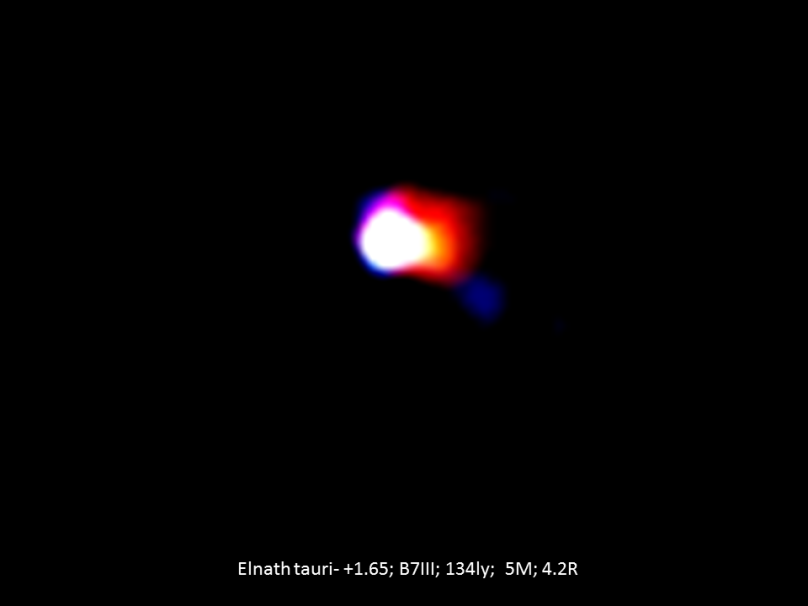 β Tauri, Elnath, is the second-brightest star after Aldebaran in the constellation of Taurus. Elnath is a non-magnetic chemically peculiar B7 giant measured at 134 light years away. It is a mercury-manganese star with unsteady periods, with unusually large signatures of heavy manganese in its spectrum but little calcium and magnesium, although it shows high levels of silicon and chromium, giving it the classification of a “SrCrEu” star. There is a faint optical double companion known as BD+28 795B.
β Tauri, Elnath, is the second-brightest star after Aldebaran in the constellation of Taurus. Elnath is a non-magnetic chemically peculiar B7 giant measured at 134 light years away. It is a mercury-manganese star with unsteady periods, with unusually large signatures of heavy manganese in its spectrum but little calcium and magnesium, although it shows high levels of silicon and chromium, giving it the classification of a “SrCrEu” star. There is a faint optical double companion known as BD+28 795B.
 Epsilon Persei is a multiple star system in the northern constellation of Perseus. It visual magnitude of +2.88 at 640ly is bright enough to be viewed with the naked eye. This is a spectroscopic binary system of mainly 2 components, of which the primary is a blue-white star and a companion orbiting the primary at a period of 14 days. The secondary component’s mass is about 6–13% of the primary’s and its stellar classification is possibly A6V. Epsilon Persei A is a Beta Cephei variable star with a rapid pulsation period typical of mainstream hot blue stars of just 0.1603 days. There may be a third white dwarf component with an orbital period of roughly 9,428 days, which would have about 51–139% of the primary’s mass.
Epsilon Persei is a multiple star system in the northern constellation of Perseus. It visual magnitude of +2.88 at 640ly is bright enough to be viewed with the naked eye. This is a spectroscopic binary system of mainly 2 components, of which the primary is a blue-white star and a companion orbiting the primary at a period of 14 days. The secondary component’s mass is about 6–13% of the primary’s and its stellar classification is possibly A6V. Epsilon Persei A is a Beta Cephei variable star with a rapid pulsation period typical of mainstream hot blue stars of just 0.1603 days. There may be a third white dwarf component with an orbital period of roughly 9,428 days, which would have about 51–139% of the primary’s mass.
 The Sun is a nearly perfect sphere of hot plasma with internal convective motion that generates a magnetic field via a dynamo process. Its diameter is about 1.39 million kilometers, and its mass is about 330,000 times that of Earth, accounting for 99.86% of the total mass of the Solar System. It is burning hydrogen with smaller quantities of heavier elements like oxygen, carbon, neon, and iron at its core. The Sun is a G-type main-sequence yellow dwarf star (G2V) formed 4.6gyr ago from the gravitational collapse of matter within a large molecular cloud. The Sun is middle-aged and will continue to burn for another another five billion years. It will mark an increase in density and temperature while its outer atmospheric layers shed and expand into a red class 3 giant. The sun is brighter than 85% of the stars in the Milky Way, most of which are red dwarfs. It is a Population I heavy-element-rich star containing gold and uranium, heavier relative to the elements in so-called Population II stars which are older, less luminous and cooler, e.g. Arcturus (7.1gyr). The solar constant is the amount of power that the Sun deposits per unit area that is perpendicular to the rays. The solar constant is equal to approximately 1.368 KW/m2 at a distance of 1 AU from the Sun. However, this is attenuated by Earth’s atmosphere so that less luminosity arrives at the surface closer to 0.55 – 1.0 KW/m2 even in clear conditions or with cirrus clouds as the sunlight is reflected or absorbed by the atmosphere.
The Sun is a nearly perfect sphere of hot plasma with internal convective motion that generates a magnetic field via a dynamo process. Its diameter is about 1.39 million kilometers, and its mass is about 330,000 times that of Earth, accounting for 99.86% of the total mass of the Solar System. It is burning hydrogen with smaller quantities of heavier elements like oxygen, carbon, neon, and iron at its core. The Sun is a G-type main-sequence yellow dwarf star (G2V) formed 4.6gyr ago from the gravitational collapse of matter within a large molecular cloud. The Sun is middle-aged and will continue to burn for another another five billion years. It will mark an increase in density and temperature while its outer atmospheric layers shed and expand into a red class 3 giant. The sun is brighter than 85% of the stars in the Milky Way, most of which are red dwarfs. It is a Population I heavy-element-rich star containing gold and uranium, heavier relative to the elements in so-called Population II stars which are older, less luminous and cooler, e.g. Arcturus (7.1gyr). The solar constant is the amount of power that the Sun deposits per unit area that is perpendicular to the rays. The solar constant is equal to approximately 1.368 KW/m2 at a distance of 1 AU from the Sun. However, this is attenuated by Earth’s atmosphere so that less luminosity arrives at the surface closer to 0.55 – 1.0 KW/m2 even in clear conditions or with cirrus clouds as the sunlight is reflected or absorbed by the atmosphere.
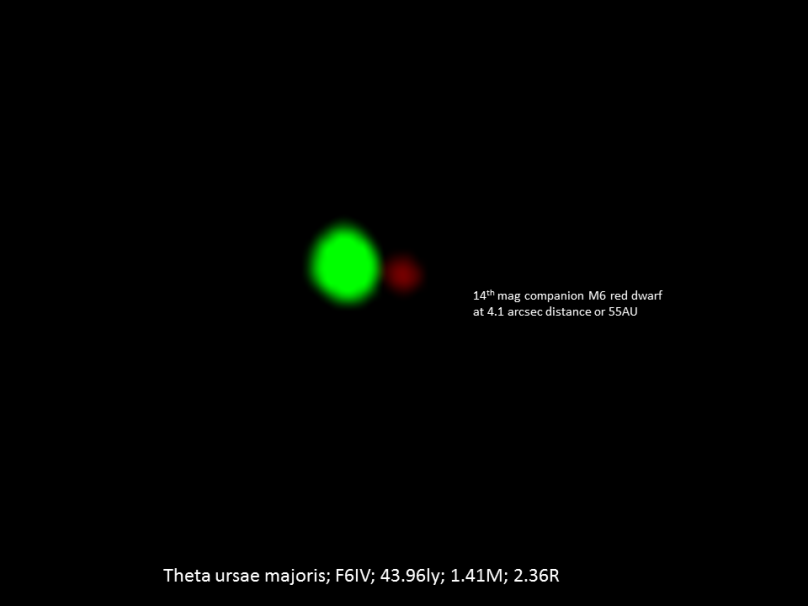 Theta Ursae Majoris is a suspected spectroscopic binary star system in the northern circumpolar constellation of Ursa Major. It has an apparent visual magnitude of 3.17. This binary system was brought into question due to insufficient data, but there is a 14th-magnitude proper motion companion to Theta Ursae Majoris at an angular separation of 4.1 arcseconds.
Theta Ursae Majoris is a suspected spectroscopic binary star system in the northern circumpolar constellation of Ursa Major. It has an apparent visual magnitude of 3.17. This binary system was brought into question due to insufficient data, but there is a 14th-magnitude proper motion companion to Theta Ursae Majoris at an angular separation of 4.1 arcseconds.
 Gamma Crucis of Crux constellation, Gacrux, is the nearest red giant star to the Sun. It is 88.6 ly with an apparent magnitude of +1.63, This is the third-brightest star in the southern circumpolar constellation of Crux-the Southern Cross. It has evolved off of the main sequence to become a red giant star, but is most likely on the red giant branch rather than the asymptotic giant branch. Althoughonly 30% more massive than the Sun, Gacrux has expanded to 84 times the Sun’s radius. The atmosphere of this star is enriched with barium, which is usually explained by the transfer of material from a more evolved companion. However, no such companion has been detected. Semiregular variable stars are giants or of late spectral type showing much periodicity from 20 to 200 days in their light changes with the light curves interrupted by various irregularities with each cycle (usually 1-2 magnitudes).
Gamma Crucis of Crux constellation, Gacrux, is the nearest red giant star to the Sun. It is 88.6 ly with an apparent magnitude of +1.63, This is the third-brightest star in the southern circumpolar constellation of Crux-the Southern Cross. It has evolved off of the main sequence to become a red giant star, but is most likely on the red giant branch rather than the asymptotic giant branch. Althoughonly 30% more massive than the Sun, Gacrux has expanded to 84 times the Sun’s radius. The atmosphere of this star is enriched with barium, which is usually explained by the transfer of material from a more evolved companion. However, no such companion has been detected. Semiregular variable stars are giants or of late spectral type showing much periodicity from 20 to 200 days in their light changes with the light curves interrupted by various irregularities with each cycle (usually 1-2 magnitudes).
 When a 1M☉ star exhausts the supply of hydrogen by nuclear fusion processes in its core, the core contracts and its temperature increases, causing the outer layers of the star to expand and then cool. The star becomes a red giant, following a track towards the upper-right hand of this diagram. Eventually, once the temperature in the core has reached approximately 4000K, helium ignition begins in the core which halts the star’s cooling and increase in luminosity, and the star instead moves down and leftwards known as the horizontal branch (for population II metal-poor stars) or red clump (for population I metal-rich stars), or a blue loop (not shown) for stars more massive than about 2M☉. After helium burning has completed in the core, the star again moves to the right and upwards, cooling and expanding as its luminosity increases. This new path is called the asymptotic branch which is almost aligned or parallel with its previous red-giant branch track, and the low mass star will become more luminous at this stage known as an AGB star. Eventually the AGB star will have a massive rise in temperature as it sheds its final atmospheric layers to become a white dwarf.
When a 1M☉ star exhausts the supply of hydrogen by nuclear fusion processes in its core, the core contracts and its temperature increases, causing the outer layers of the star to expand and then cool. The star becomes a red giant, following a track towards the upper-right hand of this diagram. Eventually, once the temperature in the core has reached approximately 4000K, helium ignition begins in the core which halts the star’s cooling and increase in luminosity, and the star instead moves down and leftwards known as the horizontal branch (for population II metal-poor stars) or red clump (for population I metal-rich stars), or a blue loop (not shown) for stars more massive than about 2M☉. After helium burning has completed in the core, the star again moves to the right and upwards, cooling and expanding as its luminosity increases. This new path is called the asymptotic branch which is almost aligned or parallel with its previous red-giant branch track, and the low mass star will become more luminous at this stage known as an AGB star. Eventually the AGB star will have a massive rise in temperature as it sheds its final atmospheric layers to become a white dwarf. Gamma Ursae Majoris, Phecda is an astrometric binary star in the constellation of Ursa Major. Along with four other stars in this well-known asterism, Phecda forms a loose association of stars known as the Ursa Major moving group. Phecda is an Ae star where hydrogen and calcium emission lines are observed in their spectra, which is surrounded by an envelope of gas binary. Its companion orange star often perturbs the Ae-type primary star, causing the primary to wobble around the barycenter. Their orbital period is 20.5 years.
Gamma Ursae Majoris, Phecda is an astrometric binary star in the constellation of Ursa Major. Along with four other stars in this well-known asterism, Phecda forms a loose association of stars known as the Ursa Major moving group. Phecda is an Ae star where hydrogen and calcium emission lines are observed in their spectra, which is surrounded by an envelope of gas binary. Its companion orange star often perturbs the Ae-type primary star, causing the primary to wobble around the barycenter. Their orbital period is 20.5 years. Beta Ursae Majoris also named Merak, is a white-hue main sequence star visible to the naked eye in the northern circumpolar constellation of Ursa Major. This star can be extended using an imaginary line drawn from Merak to Dubhe and to Polaris. It generates energy through the thermonuclear fusion of hydrogen at its core. The effective temperature of the outer envelope is about 9,225 K, radiating at a luminosity 68 times more than our sun. The presence of a circumstellar debris disk of grit dust much like those of Fomalhaut and Vega, indicates a radius of 47 AU from the host star. The amassed dust has about 0.27% the mass of the Earth.
Beta Ursae Majoris also named Merak, is a white-hue main sequence star visible to the naked eye in the northern circumpolar constellation of Ursa Major. This star can be extended using an imaginary line drawn from Merak to Dubhe and to Polaris. It generates energy through the thermonuclear fusion of hydrogen at its core. The effective temperature of the outer envelope is about 9,225 K, radiating at a luminosity 68 times more than our sun. The presence of a circumstellar debris disk of grit dust much like those of Fomalhaut and Vega, indicates a radius of 47 AU from the host star. The amassed dust has about 0.27% the mass of the Earth. cont–> Beta Ursae Majoris, Merak, is a suspected variable with spectral line from emissions as well as accreting of solar material by a white dwarf indicates a growing companion that may reach the Chandrasekhar limit of 1.44 sun’s mass. This brings up the typical white dwarf’s core material of carbon-oxygen, where the mixing results in large amounts of carbon and oxygen being brought up into the accreted layers. This could lead to a type 1a supernova due to the presence of carbon-based nuclear fusion. More matter will soon be ejected than accreted.
cont–> Beta Ursae Majoris, Merak, is a suspected variable with spectral line from emissions as well as accreting of solar material by a white dwarf indicates a growing companion that may reach the Chandrasekhar limit of 1.44 sun’s mass. This brings up the typical white dwarf’s core material of carbon-oxygen, where the mixing results in large amounts of carbon and oxygen being brought up into the accreted layers. This could lead to a type 1a supernova due to the presence of carbon-based nuclear fusion. More matter will soon be ejected than accreted. Beta Trianguli is a double-lined spectroscopic binary star system in the constellation Triangulum, and it is the brightest star in the constellation. The binary members are separated by a distance of less than 5 AU. Beta Trianguli emits infrared radiation at 100k blackbody temp explained by a circumbinary dust ring, thought to extend 50 to 400 AU away from the stars.
Beta Trianguli is a double-lined spectroscopic binary star system in the constellation Triangulum, and it is the brightest star in the constellation. The binary members are separated by a distance of less than 5 AU. Beta Trianguli emits infrared radiation at 100k blackbody temp explained by a circumbinary dust ring, thought to extend 50 to 400 AU away from the stars.
 The Alpha Persei Cluster or Melotte 20 is an open cluster in the Perseus constellation. The cluster consists of several B type stars with the most luminous member Mirfak, Alpha Persei. It is about 557ly is the age of this cluster is about 50-70 million years. Its apparent dimension or diameter is 185′ across with an apparent magnitude of +1.2.
The Alpha Persei Cluster or Melotte 20 is an open cluster in the Perseus constellation. The cluster consists of several B type stars with the most luminous member Mirfak, Alpha Persei. It is about 557ly is the age of this cluster is about 50-70 million years. Its apparent dimension or diameter is 185′ across with an apparent magnitude of +1.2.
 HD 105382, also named as V863 Centauri, is a blue-white hued giant star in the constellation Centaurus. Its apparent magnitude is +4.47 and is 440ly from the sun. HD 105382 is a rotating variable star whose amplitude varies with about +0.012 over a pulsating period of 1.3 days (which is also the rotation period). It has been previously classified as a Be star whose “Balmer Series” show spectral line emissions of the hydrogen atom. This star is a helium and silicon weak peculiar star. Regions with more helium appear to coincide with the regions with less silicon, and vice versa. In total, this may be a five star system. It is a member of the Lower Centaurus-Crux (LCC) subgroup of the Scorpius–Centaurus Association.
HD 105382, also named as V863 Centauri, is a blue-white hued giant star in the constellation Centaurus. Its apparent magnitude is +4.47 and is 440ly from the sun. HD 105382 is a rotating variable star whose amplitude varies with about +0.012 over a pulsating period of 1.3 days (which is also the rotation period). It has been previously classified as a Be star whose “Balmer Series” show spectral line emissions of the hydrogen atom. This star is a helium and silicon weak peculiar star. Regions with more helium appear to coincide with the regions with less silicon, and vice versa. In total, this may be a five star system. It is a member of the Lower Centaurus-Crux (LCC) subgroup of the Scorpius–Centaurus Association.
